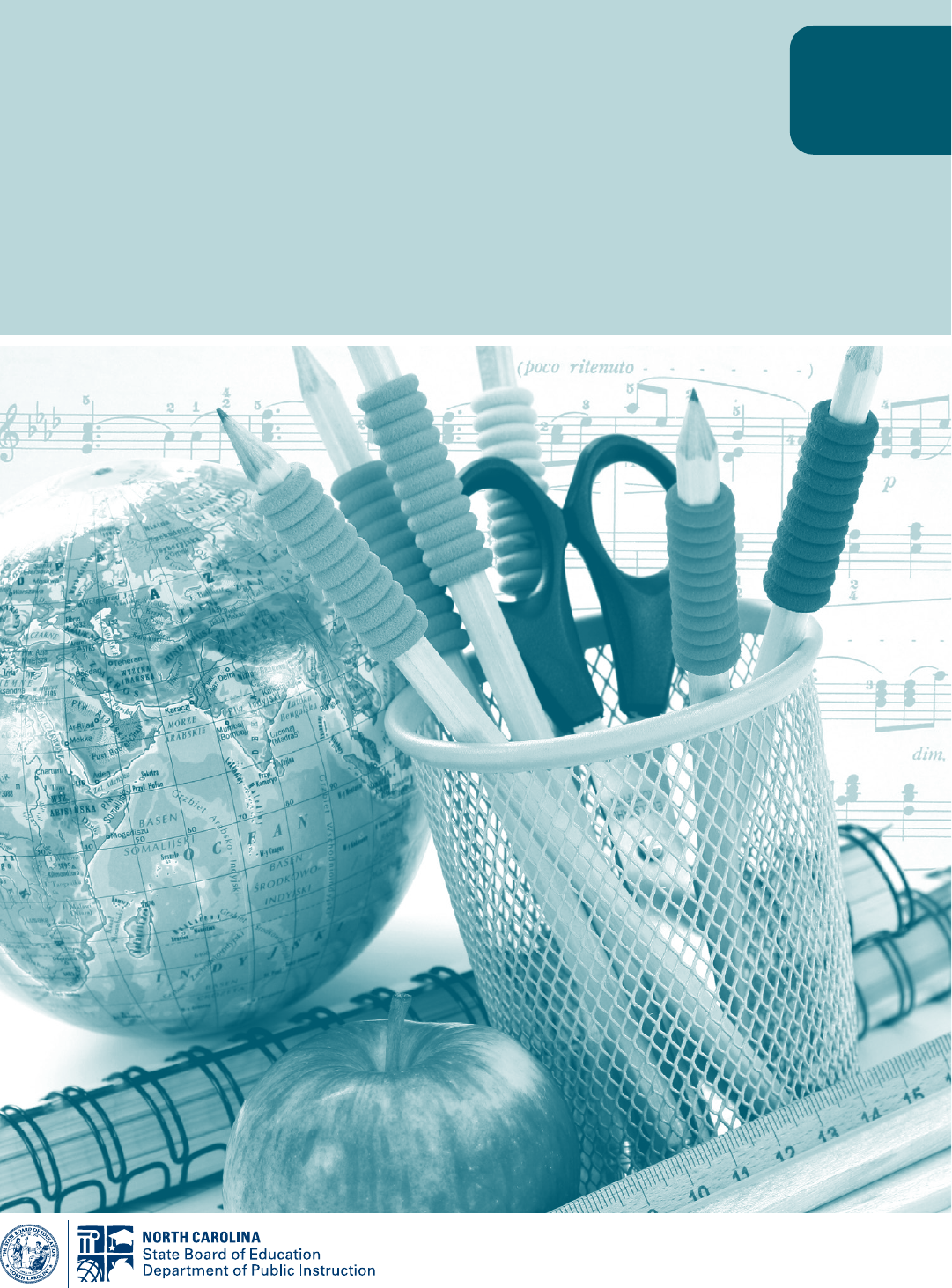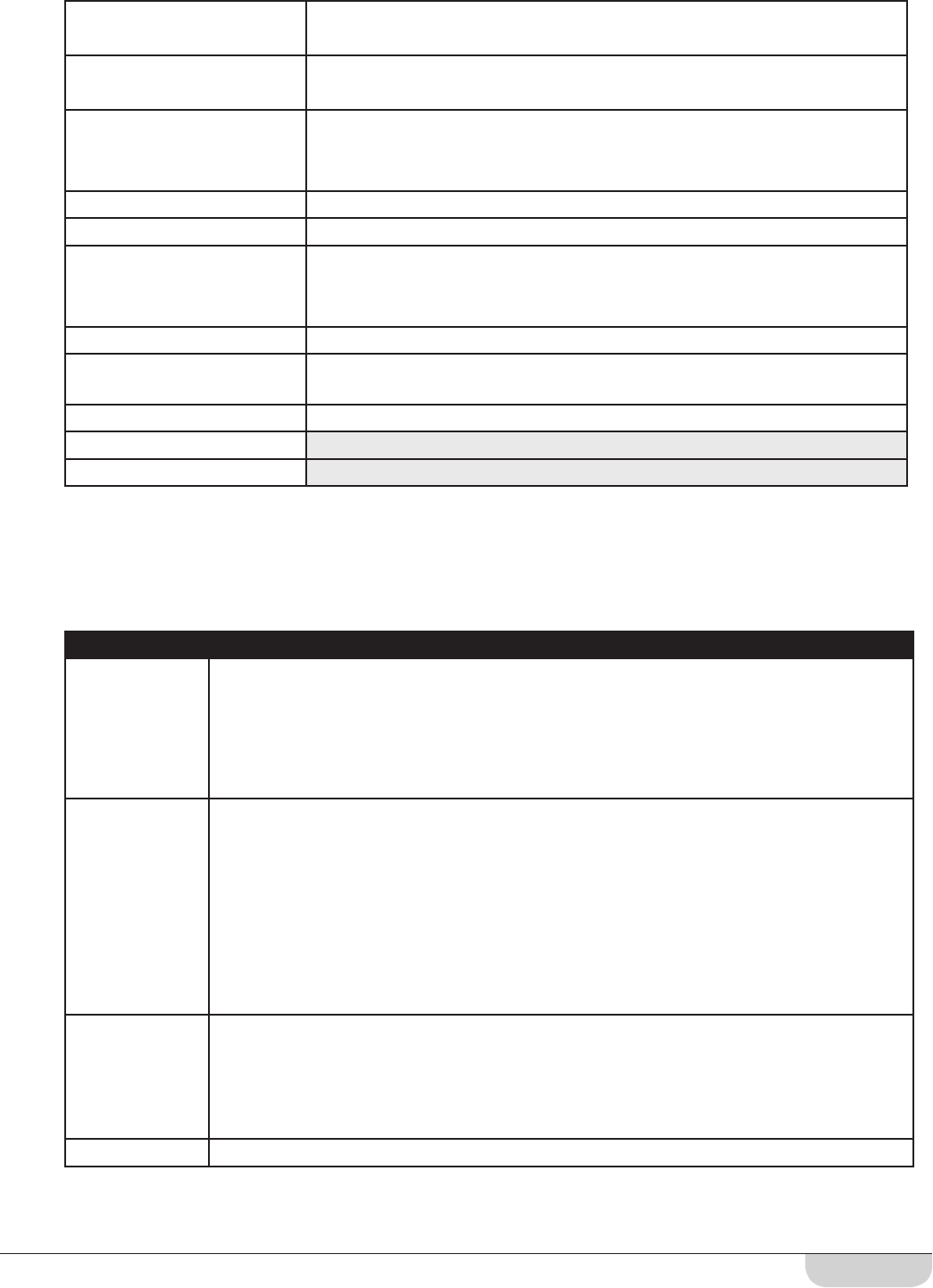
GRADE
2
Quick Reference Guide
FOR THE NORTH CAROLINA STANDARD COURSE OF STUDY
2024
ERIC DAVIS
Chair: Charlotte – At-Large
ALAN DUNCAN
Vice Chair: Greensboro – Piedmont-Triad Region
MARK ROBINSON
Lieutenant Governor: High Point – Ex Officio
DALE FOLWELL
State Treasurer: Raleigh – Ex Officio
CATHERINE TRUITT
Superintendent & Secretary to the Board: Cary
JILL CAMNITZ
Greenville – Northeast Region
REGINALD KENAN
Rose Hill – Southeast Region
VACANT
North Central Region
OLIVIA OXENDINE
Pinehurst – Sandhills Region
VACANT
Southwest Region
JOHN BLACKBURN
Linville – Northwest Region
DONNA TIPTON-ROGERS
Brasstown – Western Region
J. WENDELL HALL
Ahoskie – At-Large
CATTY MOORE
Monroe – At-Large
The above State Board of Education information is a record of the board members at the time of this document’s approval for publication.
For the current list of State Board Members, Vision and Mission Statements, go to www.dpi.nc.gov/about-dpi/state-board-education.
NC DEPARTMENT OF PUBLIC INSTRUCTION
Catherine Truitt, State Superintendent / 301 N. Wilmington Street / Raleigh, North Carolina 27601-2825
In compliance with federal law, the NC Department of Public Instruction administers all state-operated educational programs, employment activities
and admissions without discrimination because of race, religion, national or ethnic origin, color, age, military service, disability, or gender, except where
exemption is appropriate and allowed by law.
Inquiries or complaints regarding discrimination issues should be directed to:
Thomas Tomberlin, Senior Director, Educator Preparation, Licensure, and Performance, NCDPI
6301 Mail Service Center, Raleigh, NC 27699 / Phone: (984) 236-2114
Visit us on the Web: www.dpi.nc.gov 1023
STATE BOARD OF EDUCATION
STATE BOARD OF EDUCATION VISION: Every public school student in North Carolina will be empowered to accept academic
challenges, prepared to pursue their chosen path after graduating high school, and encouraged to become lifelong learners with
the capacity to engage in a globally-collaborative society.
STATE BOARD OF EDUCATION MISSION: The mission of the North Carolina State Board of Education is to use its constitutional
authority to guard and maintain the right of a sound, basic education for every child in North Carolina Public Schools.

2ND GRADE
2023 QUICK REFERENCE GUIDE
|
3
TABLE OF CONTENTS
Introduction ................................................................. 5
North Carolina Standard Course of Study by Grade Level
• Arts Education ............................................................6
– Dance ................................................................6
– Music ................................................................7
– Theatre Arts ..........................................................8
– Visual Arts ............................................................9
• Computer Science ........................................................10
• Digital Learning ..........................................................12
• English Language Arts ...................................................14
• English Language Arts Extended Content Standards ..........................20
• Healthful Living ..........................................................22
– Health Education .....................................................22
– Physical Education ....................................................23
• Mathematics ............................................................24
• Mathematics Extended Content Standards ..................................27
• Science .................................................................29
• Science Extended Content Standards .......................................30
• Social Studies ...........................................................31
• Social Studies Extended Content Standards .................................33
North Carolina Standard Course of Study by Proficiency Level
• English Language Development (for Multilingual Learners) .....................35
• Guidance ...............................................................40
• World Languages ........................................................47
GRADE
2
Quick Reference Guide
FOR THE NORTH CAROLINA STANDARD COURSE OF STUDY

2ND GRADE
4
|
2023 QUICK REFERENCE GUIDE

2ND GRADE
2023 QUICK REFERENCE GUIDE
|
5
INTRODUCTION
This Quick Reference Guide for The North Carolina Standard Course of Study is a resource for
teachers as they plan instruction to implement the North Carolina Standard Course of Study
across multiple content areas. There are nine Quick Reference Guides available – one for each of
the grade levels from kindergarten through 8th grade. The inclusion of standards for all subject
areas within single, grade-specific documents is intended to make planning for instruction
more efficient and may be particularly useful for educators teaching multiple disciplines or
collaborating to plan integrated instruction.
The Reference Guides contain the standards and objectives for each content area’s North Carolina
Standard Course of Study and North Carolina Extended Content Standards. The alternate
achievement standards are designed for students with significant cognitive disabilities so they
can have access to the Standard Course of Study at grade level. The North Carolina Extended
Content Standards were developed for English Language Arts, Mathematics, Science, and Social
Studies, and are accessible online at: https://www.dpi.nc.gov/districts-schools/classroom-
resources/exceptional-children/resources-unique-needs/significant-cognitive-disabilities/
nc-extended-content-standards.
North Carolina’s Standard Course of Study defines the appropriate content standards for each
grade level and each high school course to provide a uniform set of learning standards for every
public school in North Carolina. These standards define what students should know and be able
to do by the end of a grade and/or course.
Additional information, such as introductory materials, or other narrative may be accessed by
viewing the full version of the Standard Course of Study and Instructional Support Tools for each
discipline, accessible online at: https://www.dpi.nc.gov/districts-schools/classroom-resources/
k-12-standards-curriculum-and-instruction.
a. NC Standard Course of Study by Grade Level: Arts Education (Dance, Music, Theatre
Arts, Visual Arts), English Language Arts, Healthful Living (Health and Physical Education),
Digital Learning, Mathematics, Science, and Social Studies.
b. NC Standard Course of Study by Proficiency Level & Course: English Language
Development, Guidance, and World Languages (Classical, Dual & Heritage, and Modern)
are organized by proficiency level. A one-page summary and standards for all proficiency
levels are included for Guidance and World Languages. A one-page summary and rubrics
for proficiency placement are included for English Language Development. A one-page
summary in the 6th-8th grade guides, organized by course, is provided for Career and
Technical Education.

2ND GRADE
6
|
2023 QUICK REFERENCE GUIDE
ARTS EDUCATION – DANCE
NORTH CAROLINA STANDARD COURSE OF STUDY
CREATION AND PERFORMANCE
2.CP.1 Use choreographic principles, structures, and processes to create dances that
communicate ideas, experiences, feelings, and images.
2.CP.1.1 Use basic elements of movement to generate short dance phrases.
2.CP.1.2 Use teacher-led improvisation in the process of creating dance phrases.
2.CP.1.3 Create dance phrases with simple patterns.
2.CP.1.4 Create dance phrases that express words, ideas, experiences, and feelings.
2.CP.2 Understand how to use performance values (kinesthetic awareness, concentration,
focus, and etiquette) to enhance dance performance.
2.CP.2.1 Understand how to be respectful of self and others in a dance setting.
2.CP.2.2 Use concentration and focus during dance explorations.
2.CP.2.3 Use teacher and peer feedback to improve dance.
DANCE MOVEMENT SKILLS
2.DM.1 Understand how to use movement skills in dance.
2.DM.1.1 Exemplify isolation of body parts and use of body center.
2.DM.1.2 Illustrate a variety of body shapes in space.
2.DM.1.3 Exemplify locomotor and non-locomotor (axial) movements in performing
dance phrases.
2.DM.1.4 Recognize examples of simple rhythms and patterns in movement.
2.DM.1.5 Exemplify a variety of directions, levels, and pathways in general space.
RESPONDING
2.R.1 Use a variety of thinking skills to analyze and evaluate dance.
2.R.1.1 Distinguish movement skills and elements observed in significant dance works.
2.R.1.2 Use words or images to describe possible meanings observed in dance.
CONNECTING
2.C.1 Understand cultural, historical, and interdisciplinary connections with dance.
2.C.1.1 Exemplify dance representing the heritage, customs, and traditions of various cultures.
2.C.1.2 Understand connections between dance and concepts in other curricular areas.

2ND GRADE
2023 QUICK REFERENCE GUIDE
|
7
ARTS EDUCATION – MUSIC
NORTH CAROLINA STANDARD COURSE OF STUDY
MUSICAL LITERACY
2.ML.1 Apply the elements of music and musical techniques in order to sing and play music
with accuracy and expression.
2.ML.1.1 Apply problem solving strategies to improve musical technique when singing and
playing instruments.
2.ML.1.2 Use accurate pitch to sing three-pitch patterns.
2.ML.1.3 Execute extended rhythmic patterns using body, instruments, or voice.
2.ML.1.4 Apply changes in music to the elements of dynamics, tempo, melody, and form.
2.ML.2 Interpret the sound and symbol systems of music.
2.ML.2.1 Interpret rhythm patterns using standard notation for half and quarter notes, half and
quarter rests, and beamed eighth notes.
2.ML.2.2 Interpret three-pitch songs that use traditional music notation with voice and/or by
playing pitched instruments.
2.ML.2.3 Use standard notation to notate half and quarter notes, half and quarter rests, and
beamed eighth notes.
2.ML.3 Create music using a variety of sound and notational sources.
2.ML.3.1 Use improvisation to create simple rhythmic and melodic variations on familiar
melodies.
2.ML.3.2 Create extended rhythmic patterns over a steady beat.
2.ML.3.3 Create rhythm patterns using half and quarter notes, half and quarter rests, and
beamed eighth notes in duple and triple meter.
MUSICAL RESPONSE
2.MR.1 Understand the interacting elements to respond to music and music performances.
2.MR.1.1 Illustrate prominent musical characteristics or specific musical events while listening
to and/or singing music.
2.MR.1.2 Illustrate melodic patterns, dynamics, and forms.
2.MR.1.3 Illustrate audience and participant behavior appropriate for the purpose and setting
that music is performed.
2.MR.1.4 Differentiate various instruments based on how their sounds are produced.
CONTEXTUAL RELEVANCY
2.CR.1 Understand global, interdisciplinary, and 21st century connections with music.
2.CR.1.1 Exemplify music representing the heritage, customs, and traditions of various cultures.
2.CR.1.2 Understand the relationships between music and concepts from other areas.

2ND GRADE
8
|
2023 QUICK REFERENCE GUIDE
ARTS EDUCATION – THEATRE ARTS
NORTH CAROLINA STANDARD COURSE OF STUDY
COMMUNICATION
2.C.1 Use movement, voice, and writing to communicate ideas and feelings.
2.C.1.1 Use non-verbal expression to communicate elements of characterization, including
age and physicality.
2.C.1.2 Use vocal variety and animation to create distinct voices for characters.
2.C.1.3 Use dialogue to enhance the clarity of stories.
2.C.2 Use performance to communicate ideas and feelings.
2.C.2.1 Use improvisation to communicate problems and resolutions.
2.C.2.2 Interpret stories from previously-read texts by acting them out.
AN ALYSIS
2.A.1 Analyze literary texts and performances.
2.A.1.1 Distinguish the setting, characters, sequence of events, main idea, problem, and
solution for a variety of stories.
2.A.1.2 Analyze the relationships between events, characters, and settings.
AESTHETICS
2.AE.1 Understand how to design technical theatre components, such as costumes, sets, props,
makeup, lighting, and sound.
2.AE.1.1 Explain how space affects performances.
2.AE.1.2 Understand how the use of costumes, props, and masks enhance dramatic play.
CULTURE
2.CU.1 Analyze theatre in terms of the social, historical, and cultural contexts in which it
was created.
2.CU.1.1 Exemplify theatrical works representing the heritage, customs, and traditions of
various cultures.
2.CU.1.2 Explain the impact of media, such as theatre, film, the Internet, and television, on
family life.
2.CU.2 Understand the traditions, roles, and conventions of theatre as an art form.
2.CU.2.1 Illustrate how to share focus with others in a group setting.
2.CU.2.2 Summarize the role of the director or acting coach.

2ND GRADE
2023 QUICK REFERENCE GUIDE
|
9
ARTS EDUCATION – VISUAL ARTS
NORTH CAROLINA STANDARD COURSE OF STUDY
VISUAL LITERACY
2.V.1 Use the language of visual arts to communicate effectively.
2.V.1.1 Use appropriate art vocabulary when discussing media, processes, or images in art.
2.V.1.2 Create original art that expresses ideas about people, neighborhoods, or communities.
2.V.1.3 Understand the “story” in works of art.
2.V.1.4 Understand characteristics of the Elements of Art, including lines, shapes, colors,
textures, form, space, and value.
2.V.1.5 Understand characteristics of the Principles of Design, including repetition, movement,
emphasis, contrast, balance, and proportion.
2.V.2 Apply creative and critical thinking skills to artistic expression.
2.V.2.1 Understand that artistic problems have multiple solutions.
2.V.2.2 Use personal point of view of the environment as a source of imagery.
2.V.2.3 Create art from real and imaginary sources of inspiration.
2.V.3 Create art using a variety of tools, media, and processes, safely and appropriately.
2.V.3.1 Use a variety of tools safely and appropriately to create art.
2.V.3.2 Recognize characteristics of a variety of media.
2.V.3.3 Use the processes of drawing, painting, weaving, printing, stitchery, collage, mixed
media, sculpture, and ceramics to create art.
CONTEXTUAL RELEVANCY
2.CX.1 Understand the global, historical, societal, and cultural contexts of the visual arts.
2.CX.1.1 Exemplify visual arts representing the heritage, customs, and traditions of
various cultures.
2.CX.1.2 Recognize that works of art represent specific time periods.
2.CX.1.3 Understand various movements in art and the artists that represent them.
2.CX.1.4 Compare art from various cultures.
2.CX.1.5 Understand that artists use natural resources in creating art.
2.CX.2 Understand the interdisciplinary connections and life applications of the visual arts.
2.CX.2.1 Recognize the impact of regional differences on the production of art.
2.CX.2.2 Understand relationships between art and concepts from other disciplines, such as
math, science, language arts, social studies, and other arts.
2.CX.2.3 Recognize that some artists work in teams to create art.
CRITICAL RESPONSE
2.CR.1 Use critical analysis to generate responses to a variety of prompts.
2.CR.1.1 Use art terminology to describe art in terms of subject and physical characteristics.
2.CR.1.2 Evaluate personal work, while in progress and at completion.

2ND GRADE
10
|
2023 QUICK REFERENCE GUIDE
COMPUTER SCIENCE
NORTH CAROLINA STANDARD COURSE OF STUDY
COMPUTING SYSTEMS
Devices
K2-CS-01 Choose appropriate devices to perform a variety of classroom tasks.
Hardware & Software
K2-CS-02 Describe the function of common physical components of computing systems
(hardware) with appropriate terminology.
K2-CS-03 Operate appropriate software to perform a variety of tasks.
Troubleshooting
K2-CS-04 Describe basic hardware and software problems with accurate terminology.
NETWORKS & THE INTERNET
Network Communication & Organization
K2-NI-01 Illustrate how information is broken down into smaller pieces and can be reassembled.
Cybersecurity
K2-NI-02 Apply knowledge of what passwords are and why we use strong passwords to
protect devices and information from unauthorized access.
K2-NI-03 Discover your digital footprint and how personal information can be protected.
DATA & ANALYSIS
Storage
K2-DA-01 Store, copy, search, retrieve, modify, and delete information using a computing device.
K2-DA-02 Define information stored on a computing device as data.
Collection, Visualization & Transformation
K2-DA-03 Collect and present the same data in various visual formats.
Inference & Models
K2-DA-04 Make predictions with patterns in data visualizations.
ALGORITHMS & PROGRAMMING
Algorithms
K2-AP-01 Model daily processes with algorithms to complete tasks.
Variables
K2-AP-02 Demonstrate how programs store and manipulate data by using numbers or
other symbols to represent information.
Control
K2-AP-03 Develop programs with sequences and simple loops to express ideas or
address a problem.
K2-AP-04 Decompose the steps needed to solve a problem into a precise sequence
of instructions.

2ND GRADE
2023 QUICK REFERENCE GUIDE
|
11
Modularity
K2-AP-04 Decompose the steps needed to solve a problem into a precise sequence
of instructions.
Program Development
K2-AP-05 Develop plans that describe a program’s sequence of events, goals and
expected outcomes.
K2-AP-06 Give attribution when using the ideas and creations of others while
developing programs.
K2-AP-07 Identify and debug errors in an algorithm or program that includes sequences
and simple loops.
K2-AP-08 Using correct terminology, describe steps taken and choices made during the
iterative process of program development.
IMPACTS OF COMPUTING
Culture
K2-IC-01 Compare how people live and work before and after the implementation or adoption
of new computing technology.
K2-IC-02 Select software that meets the diverse needs and preferences for the technology
individuals use in the classroom.
Social Interactions
K2-IC-03 Work respectfully and responsibly with others online.
Safety, Law & Ethics
K2-IC-04 Model responsible login and logoff procedures on all devices.

2ND GRADE
12
|
2023 QUICK REFERENCE GUIDE
DIGITAL LEARNING
NORTH CAROLINA STANDARD COURSE OF STUDY
The standards are critical building blocks for our students and are designed to be delivered in all curricular
areas and grade levels. In order to appropriately plan and deliver the integrated Digital Learning Standard
Course of Study, collaborative planning should occur in grade level planning teams which include media
coordinators and technology facilitators.
Standards reprinted by permission of “ISTE Standards for Students.” ISTE© – International Society for
Technology in Education, 12 August 2019, www.iste.org/standards/for-students.
EMPOWERED LEARNER
1. Students leverage technology to take an active role in choosing, achieving and demonstrating
competency in their learning goals, informed by the learning sciences.
1a. Students articulate and set personal learning goals, develop strategies leveraging
technology to achieve them and reflect on the learning process itself to improve
learning outcomes.
1b. Students build networks and customize their learning environments in ways that support
the learning process.
1c. Students use technology to seek feedback that informs and improves their practice and to
demonstrate their learning in a variety of ways.
1d. Students understand the fundamental concepts of technology operations, demonstrate the
ability to choose, use and troubleshoot current technologies and are able to transfer their
knowledge to explore emerging technologies.
DIGITAL CITIZEN
2. Students recognize the rights, responsibilities and opportunities of living, learning and
working in an interconnected digital world, and they act and model in ways that are safe,
legal and ethical.
2a. Students cultivate and manage their digital identity and reputation and are aware of the
permanence of their actions in the digital world.
2b. Students engage in positive, safe, legal and ethical behavior when using technology,
including social interactions online or when using networked devices.
2c. Students demonstrate an understanding of and respect for the rights and obligations of
using and sharing intellectual property.
2d. Students manage their personal data to maintain digital privacy and security and are
aware of data-collection technology used to track their navigation online.
KNOWLEDGE CONSTRUCTOR
3. Students critically curate a variety of resources using digital tools to construct knowledge,
produce creative artifacts and make meaningful learning experiences for themselves
and others.
3a. Students plan and employ effective research strategies to locate information and other
resources for their intellectual or creative pursuits.
3b. Students evaluate the accuracy, perspective, credibility and relevance of information,
media, data or other resources.
3c. Students curate information from digital resources using a variety of tools and methods
to create collections of artifacts that demonstrate meaningful connections or conclusions.
3d. Students build knowledge by actively exploring real-world issues and problems,
developing ideas and theories and pursuing answers and solutions.

2ND GRADE
2023 QUICK REFERENCE GUIDE
|
13
INNOVATIVE DESIGNER
4. Students use a variety of technologies within a design process to identify and solve problems
by creating new, useful or imaginative solutions.
4a. Students know and use a deliberate design process for generating ideas, testing theories,
creating innovative artifacts or solving authentic problems.
4b. Students select and use digital tools to plan and manage a design process that considers
design constraints and calculated risks.
4c. Students develop, test and refine prototypes as part of a cyclical design process.
4d. Students exhibit a tolerance for ambiguity, perseverance and the capacity to work with
open-ended problems.
COMPUTATIONAL THINKER
5. Students develop and employ strategies for understanding and solving problems in ways
that leverage the power of technological methods to develop and test solutions.
5a. Students formulate problem definitions suited for technology-assisted methods such as
data analysis, abstract models and algorithmic thinking in exploring and finding solutions.
5b. Students collect data or identify relevant data sets, use digital tools to analyze them, and
represent data in various ways to facilitate problem-solving and decision-making.
5c. Students break problems into component parts, extract key information, and develop
descriptive models to understand complex systems or facilitate problem-solving.
5d. Students understand how automation works and use algorithmic thinking to develop a
sequence of steps to create and test automated solutions.
CREATIVE COMMUNICATOR
6. Students communicate clearly and express themselves creatively for a variety of purposes
using the platforms, tools, styles, formats and digital media appropriate to their goals.
6a. Students choose the appropriate platforms and tools for meeting the desired objectives
of their creation or communication.
6b. Students create original works or responsibly repurpose or remix digital resources into
new creations.
6c. Students communicate complex ideas clearly and effectively by creating or using a variety
of digital objects such as visualizations, models or simulations.
6d. Students publish or present content that customizes the message and medium for their
intended audiences.
GLOBAL COLLABORATOR
7. Students use digital tools to broaden their perspectives and enrich their learning by
collaborating with others and working effectively in teams locally and globally.
7a. Students use digital tools to connect with learners from a variety of backgrounds and
cultures, engaging with them in ways that broaden mutual understanding and learning.
7b. Students use collaborative technologies to work with others, including peers, experts or
community members, to examine issues and problems from multiple viewpoints.
7c. Students contribute constructively to project teams, assuming various roles and
responsibilities to work effectively toward a common goal.
7d. Students explore local and global issues and use collaborative technologies to work with
others to investigate solutions.

2ND GRADE
14
|
2023 QUICK REFERENCE GUIDE
ENGLISH LANGUAGE ARTS
NORTH CAROLINA STANDARD COURSE OF STUDY
READING STRAND
K-12 Standards for Reading define what students should understand and be able to do by the end
of each grade. Students should demonstrate their proficiency of these standards both orally and
through writing. For students to be college and career ready, they must read from a wide range of
high-quality, increasingly challenging literary and informational texts. One of the key requirements
of the Standards for Reading is that all students must be able to comprehend texts of steadily
increasing complexity as they progress through school. Students should also acquire the habits
of reading closely and independently for sustained periods of time. They need to connect prior
knowledge and experiences to text. They must also show a steadily growing ability to discern
more from and make fuller use of text.
READING STANDARDS FOR LITERATURE
Key Ideas and Evidence
RL.2.1 Ask and answer such questions as who, what, where, when, why, and how to
demonstrate understanding of key details in a text.
RL.2.2 Recount stories, including fables and folktales from diverse cultures, and determine
their central message, lesson, or moral.
RL.2.3 Describe how characters in a story respond to major events and challenges.
Craft and Structure
RL.2.4 Describe how words and phrases supply rhythm and meaning in a story, poem, or song.
RL.2.5 Describe the overall structure of a story, including describing how the beginning
introduces the story, the events unfold in the middle, and the ending concludes the
action.
RL.2.6 Distinguish differences in the points of view of characters, including by speaking in a
different voice for each character when reading dialogue aloud.
Integration of Ideas and Analysis
RL.2.7 Use information gained from the illustrations and words in a print or digital text to
demonstrate understanding of its characters, setting, or plot.
RL.2.8 Not applicable to literature.
RL.2.9 Compare and contrast two or more versions of the same story by different authors or
from different cultures.
Range of Reading and Level of Complexity
RL.2.10 By the end of grade 2, read and understand literature within the 2-3 text complexity
band proficiently and independently for sustained periods of time. Connect prior
knowledge and experiences to text.
READING STANDARDS FOR INFORMATIONAL TEXT
Key Ideas and Evidence
RI.2.1 Ask and answer such questions as who, what, where, when, why, and how to
demonstrate understanding of key details in a text.
RI.2.2 Identify the main topic of a multi-paragraph text as well as the focus of specific
paragraphs within the text.
RI.2.3 Describe the connection between a series of historical events, scientific ideas or
concepts, or steps in technical procedures in a text.

2ND GRADE
2023 QUICK REFERENCE GUIDE
|
15
Craft and Structure
RI.2.4 Determine the meaning of words and phrases in a text relevant to a grade 2 topic or
subject area.
RI.2.5 Know and use various text features to locate key facts or information in a text efficiently.
RI.2.6 Identify the author’s main purpose of a text, including what the author wants to
answer, explain, or describe.
Integration of Ideas and Analysis
RI.2.7 Explain how specific images contribute to and clarify a text.
RI.2.8 Identify the reasons an author gives to support ideas in a text.
RI.2.9 Compare and contrast the most important points presented by two texts on the
same topic.
Range of Reading and Level of Complexity
RI.2.10 By the end of grade 2, read and understand informational texts within the 2-3 text
complexity band proficiently and independently for sustained periods of time.
Connect prior knowledge and experiences to text.
READING FOUNDATIONAL SKILLS
The foundational skills are directed toward fostering students’ understanding and working
knowledge of concepts of print, the alphabetic principle, and other basic conventions of the English
writing system, including handwriting. These foundational skills are necessary and important
components of an effective, comprehensive reading program designed to develop proficient
readers with the capacity to comprehend texts across a range of types and disciplines. A systematic
approach to handwriting instruction (manuscript and cursive) in the elementary grades is essential
for students to communicate their ideas clearly. To achieve handwriting proficiency, students need
to apply their handwriting skills to authentic writing activities. Instruction in the foundational skills
should be differentiated. The point is to teach students what they need to learn and not what they
already know – to discern when particular children or activities warrant more or less attention.
READING STANDARDS FOR FOUNDATIONAL SKILLS
Handwriting
RF.2.2 Print all upper- and lowercase letters legibly and proportionally.
Phonics and Word Recognition
RF.2.4 Know and apply grade-level phonics and word analysis skills in decoding words.
a. Distinguish long and short vowels when reading regularly spelled one-syllable words.
b. Know spelling-sound correspondences for additional common vowel teams.
c. Decode regularly spelled two-syllable words with long vowels.
d. Decode words with common prefixes and suffixes.
e. Identify words with inconsistent but common spelling-sound correspondences.
f. Recognize and read grade-appropriate irregularly spelled words.
Fluency
RF.2.5 Read with sufficient accuracy and fluency to support comprehension.
a. Read on-level text with purpose and understanding.
b. Read on-level text orally with accuracy, appropriate rate, and expression on
successive readings.
c. Use context to confirm or self-correct word recognition and understanding,
rereading as necessary.

2ND GRADE
16
|
2023 QUICK REFERENCE GUIDE
WRITING STRAND
To be college and career ready, students should learn how to offer and support opinions/
arguments, demonstrate understanding of a topic under study, and convey real and/or imagined
experiences. Students learn that a key purpose of writing is to communicate clearly and
coherently. The NC ELA Writing Standards emphasize the importance of writing routinely
in order to build knowledge and demonstrate understanding. The complete writing process
(from prewriting to editing) is clear in the first three writing standards. These standards define
what students should understand and be able to do by the end of each grade.
WRITING STANDARDS
Text Types, Purposes, and Publishing
W.2.1 Write opinion pieces in which they introduce the topic or book they are writing about,
state an opinion, supply reasons that support the opinion, use linking words to connect
opinion and reasons, and provide a concluding statement or section.
a. With guidance and support from adults, organize information and ideas around a
topic to plan and prepare to write.
b. With guidance and support from adults and peers, focus on a topic and strengthen
writing as needed by revising and editing.
W.2.2 Write informative /explanatory texts in which they introduce a topic, use facts and
definitions to develop points, and provide a concluding statement or section.
a. With guidance and support from adults, organize information and ideas around a
topic to plan and prepare to write.
b. With guidance and support from adults and peers, focus on a topic and strengthen
writing as needed by revising and editing.
W.2.3 Write narratives in which they recount a well-elaborated event or short sequence
of events, include details to describe actions, thoughts, and feelings, use temporal
transition words to signal event order, and provide a sense of closure.
a. With guidance and support from adults, organize information and ideas around a
topic to plan and prepare to write.
b. With guidance and support from adults and peers, focus on a topic and strengthen
writing as needed by revising and editing.
W.2.4 With guidance and support from adults, use a variety of digital tools and resources to
produce and publish writing, including in collaboration with peers.
Research
W.2.5 Participate in shared research and writing projects.
W.2.6 Recall information from experiences or gather information from provided sources to
answer a question.
SPEAKING AND LISTENING STRAND
The K-12 Speaking and Listening Standards define what students should understand and be
able to do by the end of each grade. To become college and career ready, teachers must provide
students with ample opportunities to communicate their thinking orally through a variety of rich,
structured conversations either in whole group or in small group settings, or with a partner. To
be a productive part of these conversations, students need to contribute accurate information,
respond and build on the ideas of others, use data and evidence effectively, and listen attentively
to others.

2ND GRADE
2023 QUICK REFERENCE GUIDE
|
17
SPEAKING AND LISTENING STANDARDS
Collaboration and Communication
SL.2.1 Participate in collaborative conversations with diverse partners about grade 2 topics
and texts with peers and adults in small and larger groups.
a. Follow agreed-upon rules for discussions.
b. Build on others’ talk in conversations by linking their comments to the remarks
of others.
c. Ask for clarification and further explanation as needed about the topics and texts
under discussion.
SL.2.2 Recount or describe key ideas or details from a text read aloud or information
presented orally or through other media.
SL.2.3 Ask and answer questions about what a speaker says in order to clarify comprehension,
gather additional information, or deepen understanding of a topic or issue.
Presentation of Knowledge and Ideas
SL.2.4 Tell a story or recount an experience with appropriate facts and relevant, descriptive
details, speaking audibly in coherent and complete sentences.
SL.2.5 Create audio recordings of stories or poems; add drawings or other visual displays
to stories or recounts of experiences when appropriate to clarify ideas, thoughts,
and feelings.
LANGUAGE STRAND
Language skills are inseparable from and vital to reading, writing, speaking, and listening. Even
though these skills are in a separate strand, it is important for students to use effective and
correct language skills in all contexts. The NC ELA Language Standards emphasize the use of
accurate language skills, not just the identification of accurate language skills. The Grammar and
Conventions Grade Band Continuums allow for differentiation and re-teaching as needed. It is
important that students begin to demonstrate proficiency in the lower grade(s) of each band, while
students in the highest grade of the band should demonstrate proficiency of the listed language
skills by the end of the school year.
LANGUAGE STANDARDS
Conventions of Standard English
L.2.1 Demonstrate command of the conventions of standard English grammar and usage
when writing or speaking; demonstrate proficiency within the 2-3 grammar continuum.
Language Standards – Grammar Continuum
Skill 2-3
Subject/Verb Agreement • Ensure subject/verb agreement
Nouns • Explain the function of nouns
• Use collective nouns (such as group)
• Form and use frequently occurring regular and irregular plural nouns
Verbs • Explain the function of verbs
• Form and use past tense of frequently occurring irregular verbs
• Form and use regular and irregular verbs
• Form and use simple verb tenses
• Form and use the perfect verb tenses
• Convey sense of various times, sequences
• Recognize inappropriate shifts in verb tense

2ND GRADE
18
|
2023 QUICK REFERENCE GUIDE
Adjectives • Explain the function of adjectives
• Accurately choose which to use – adjective or adverb
Conjunctions • Explain the function of conjunctions
• Use coordinating and subordinating conjunctions
Adverbs • Accurately choose which to use – adjective or adverb
• Explain the function of adverbs
• Form and use comparative adverbs
Sentences • Produce, expand, and rearrange simple and compound sentences
Prepositions • Explain the function of prepositions
Pronouns • Explain the function of pronouns
• Continue to use personal, possessive, and indefinite pronouns
• Use reflexive pronouns
Determiners • Correctly use a, an, and the
Commonly Confused
Words
• Correctly use common homophones
Interjections • Explain the function of and use interjections
Phrases & Clauses
Usage
L.2.2 Demonstrate command of the conventions of standard English capitalization,
punctuation, and spelling when writing; demonstrate proficiency within the 2-3
conventions continuum.
Language Standards – Conventions Continuum
Skill 2-3
Capitalization • Capitalize holidays
• Capitalize product names
• Capitalize geographic names
• Capitalize appropriate words in titles
• Use correct capitalization
Punctuation • Use commas to separate single words in a series
• Use commas in greetings and closings of letters
• Use an apostrophe to form contractions
• Use an apostrophe to form frequently occurring possessives
• Use commas in addresses
• Use commas in dialogue
• Form and use possessives
• Use quotation marks in dialogue
Spelling • Use conventional spelling for high frequency and other studied words and for
adding suffixes to base words
• Use spelling patterns and generalizations (such as word families, position-
based spellings, syllable patterns, ending rules, and meaningful word parts)
when writing words
References • Consult reference materials as needed to check and correct spellings

2ND GRADE
2023 QUICK REFERENCE GUIDE
|
19
Knowledge of Language
L.2.3 Use knowledge of language and its conventions when writing, speaking, reading,
or listening.
a. Compare formal and informal uses of English.
Vocabulary Acquisition and Use
L.2.4 Determine and/or clarify the meaning of unknown and multiple-meaning words and
phrases based on grade 2 reading and content, choosing flexibly from an array of
strategies: context clues, word parts, word relationships, and reference materials.
L.2.5 Demonstrate understanding of nuances in word meanings.
a. Distinguish shades of meaning among closely related verbs and closely
related adjectives.
L.2.6 Use words and phrases learned through conversations, reading and being read to, and
responding to texts, including using adjectives and adverbs to describe.

2ND GRADE
20
|
2023 QUICK REFERENCE GUIDE
ENGLISH/LANGUAGE ARTS
EXTENDED CONTENT STANDARDS
READING STANDARDS FOR LITERATURE
Key Ideas and Evidence
RL.2.1 Answer who and what, where, questions to demonstrate understanding of details
in a familiar text.
RL.2.2 Recount events from familiar stories from diverse cultures.
RL.2.3 Identify the actions of the characters in a story.
Craft and Structure
RL.2.4 Use rhyming or repetition to identify words that meaningfully complete a line in
a familiar story, poem, or song.
RL.2.5 Determine the beginning and ending of a familiar story with a logical order.
RL.2.6 Identify the speakers in a dialogue.
Integration of Ideas and Analysis
RL.2.7 Identify illustrations or objects/tactual information in print or digital text that
depict characters.
RL.2.9 Identify similarities between two versions of the same story.
Range of Reading and Level of Complexity
RL.2.10 Actively engage in group reading for the purpose of connecting prior knowledge
and experiences to text
READING STANDARDS FOR INFORMATIONAL TEXT
Key Ideas and Evidence
RI.2.1 Answer who and what, where questions to demonstrate understanding of details
in a familiar text.
RI.2.2 Identify the main topic of text.
RI.2.3 Identify individuals, events, or details in an informational text.
Craft and Structure
RI.2.4 Identify words that relate to the topic of a text.
RI.2.5 Locate key facts or information in a familiar text.
RI.2.6 Identify the purpose of the author and the illustrator.
Integration of Ideas and Analysis
RI.2.7 Identify images, objects, or tactuals that illustrate key ideas in a text.
RI.2.8 Identify points an author makes in a familiar informational text.
RI.2.9 Identify a common element between two texts on the same topic.
Range of Reading and Level of Complexity
RI.2.10 Actively engage in group reading of information text for the purpose of connecting
prior knowledge and experiences to text.

2ND GRADE
2023 QUICK REFERENCE GUIDE
|
21
READING STANDARDS FOR FOUNDATIONAL SKILLS
Handwriting
RF.2.1 Selects or produces letters when asked to write.
RF.2.2 Demonstrate understanding of spoken words, syllables, and sounds (phonemes).
RF.2.5 Engage in purposeful reading of familiar text.
a. Read familiar text comprised of known words.
WRITING STANDARDS
Text Types, Purposes, and Publishing
W.2.1 Select a topic and use drawing, dictating, or writing to state an opinion about it.
W.2.2 Select a topic and use drawing, dictating, or writing to create a written product with
one or more facts about the topic.
W.2.3 Select an event or personal experience and use drawing, writing, or dictating to
compose a message about it.
W.2.4 With guidance and support from adults and peers, use digital tools to produce and
publish writing.
Research
W.2.5 Participate in shared research and writing projects.
W.2.6 Identify information related to personal experiences and answer simple questions
about those experiences.
SPEAKING AND LISTENING STANDARDS
Collaboration and Communication
SL.2.1 Communicate with others.
a. Engage in multiple-turn exchanges with peers with support from an adult.
b. Build on others’ talk in conversations by linking their comments to the remarks
of others.
c. Ask for clarification and further explanation as needed about the topics and texts
under discussion.
SL.2.2 During shared reading, answer who and what questions.
SL.2.3 Answer who and what questions about the details provided by the speaker.
SL.2.4 Communicate about a personal experience or event.
SL.2.5 Select visual, audio, or tactual representations that support communication about a
personal experience.
LANGUAGE
Conventions of Standard English
L.2.1 Demonstrate understanding of letter and word use within the 2-3 grammar continuum
when writing or communicating.
L.2.2 Demonstrate emerging understanding of conventions of standard English during
shared writing within 2-3 conventions continuum when writing.
L.2.3 Use symbolic language to achieve desired outcomes when communicating.
L.2.4 Demonstrate knowledge of word meanings drawn from grade 2 content.
L.2.5 Demonstrate understanding of word relationships and use.
a. Demonstrate understanding of the meaning of commonly occurring verbs.
L.2.6 Use words acquired through conversations, being read to, and during shared
reading activities.

2ND GRADE
22
|
2023 QUICK REFERENCE GUIDE
HEALTHFUL LIVING – HEALTH EDUCATION
NORTH CAROLINA STANDARD COURSE OF STUDY
MENTAL AND EMOTIONAL HEALTH
2.MEH.1 Understand the relationship among healthy expression of emotions, mental health, and
healthy behavior.
2.MEH.1.1 Identify appropriate standards for behavior.
2.MEH.1.2 Summarize behaviors that help to avoid risks.
2.MEH.1.3 Explain the influence of peers, the media, and the family on feelings and emotions.
2.MEH.1.4 Explain the influence on self-concept on performance and vice versa.
2.MEH.1.5 Summarize the potential negative effects of stress on the body and mind.
PERSONAL AND CONSUMER HEALTH
2.PCH.1 Apply measures for cleanliness and disease prevention.
2.PCH.1.1 Recall the benefits of good dental health.
2.PCH.1.2 Execute the proper techniques for brushing teeth.
2.PCH.2 Understand wellness, disease prevention, and recognition of symptoms.
2.PCH.2.1 Summarize reasons and strategies for preventing contact with body fluids.
2.PCH.2.2 Explain the dangers associated with excessive sun exposure (e.g., sun burn, damage to
eyes, skin cancer) and methods for protecting oneself from these dangers.
INTERPERSONAL COMMUNICATION AND RELATIONSHIPS
2.ICR.1 Understand healthy and effective interpersonal communication and relationships.
2.ICR.1.1 Classify behaviors as helpful or hurtful to friendships.
2.ICR.1.2 Interpret the feelings of others and how to respond when angry or sad.
2.ICR.1.3 Explain why it is wrong to tease others.
2.ICR.1.4 Recognize bullying behaviors and what to do if someone is bullied.
2.ICR.1.5 Exemplify how to communicate with others with kindness and respect.
NUTRITION AND PHYSICAL ACTIVITY
2.NPA.1 Understand MyPlate as a tool for selecting nutritious foods.
2.NPA.1.1 Recognize the interrelationship of parts of MyPlate.
2.NPA.1.2 Plan meals that are chosen for energy and health.
2.NPA.1.3 Classify activities in terms of their appropriateness for a healthy lifestyle.
2.NPA.2 Understand the importance of consuming a variety of nutrient dense foods and beverages
in moderation.
2.NPA.2.1 Summarize motivations for eating food, including hunger vs. satiety.
2.NPA.2.2 Explain the importance of a healthy breakfast and lunch.
2.NPA.3 Remember nutrition and fitness concepts to enhance quality of life.
2.NPA.3.1 Contrast a physically active and inactive lifestyle.
ALCOHOL, TOBACCO, AND OTHER DRUGS
2.ATOD.1 Understand how to use household products and medicines safely.
2.ATOD.1.1 Classify uses of medicine or drugs as appropriate and inappropriate.
2.ATOD.1.2 Summarize the health risks associated with inappropriate medicine and drug use.
2.ATOD.1.3 Use goal-setting strategies to prevent the misuse of medicines or household products.

2ND GRADE
2023 QUICK REFERENCE GUIDE
|
23
HEALTHFUL LIVING – PHYSICAL EDUCATION
NORTH CAROLINA STANDARD COURSE OF STUDY
MOTOR SKILL DEVELOPMENT
2.MS.1 Apply competent motor skills and movement patterns needed to perform a variety of
physical activities.
PE.2.MS.1.1 Execute combinations of locomotor skills in different pathways, levels, or directions.
PE.2.MS.1.2 Execute a variety of manipulative skills while maintaining good balance and follow-
through.
PE.2.MS.1.3 Generate smooth and timely transitions between sequential locomotor skills.
MOVEMENT CONCEPTS
2.MC.2 Understand concepts, principles, strategies and tactics that apply to the learning and
performance of movement.
PE.2.MC.2.1 Use equipment to illustrate multiple movement concepts.
PE.2.MC.2.2 Compare three or more of the essential elements of correct form for the five
fundamental manipulative skills.
PE.2.MC.2.3 Explain the value of feedback in improving motor performance.
PE.2.MC.2.4 Illustrate activities that are associated with three or more of the five components of
health-related fitness.
HEALTH-RELATED FITNESS
2.HF.3 Understand the importance of achieving and maintaining a health-enhancing level of
physical fitness.
PE.2.HF.3.1 Recognize three or more of the five health-related fitness assessments and the
associated exercises.
PE.2.HF.3.2 Identify enjoyable and challenging physical activities that one can do for increasing
periods of time without stopping.
PE.2.HF.3.3 Implement a weekly plan of moderate to vigorous activity that increases breathing
and heart rate.
PERSONAL/SOCIAL RESPONSIBILITY
2.PR.4 Use behavioral strategies that are responsible and enhance respect of self and others and
value activity.
PE.2.PR.4.1 Explain the value of working cooperatively in group settings.
PE.2.PR.4.2 Summarize the benefits of positive social interaction as to make activities
more enjoyable.
PE.2.PR.4.3 Use safe practices when engaging in physical education activities with little or
no prompting.

2ND GRADE
24
|
2023 QUICK REFERENCE GUIDE
MATHEMATICS
NORTH CAROLINA STANDARD COURSE OF STUDY
STANDARDS FOR MATHEMATICAL PRACTICE
1. Make sense of problems and persevere in solving them.
2. Reason abstractly and quantitatively.
3. Construct viable arguments and critique the reasoning of others.
4. Model with mathematics.
5. Use appropriate tools strategically.
6. Attend to precision.
7. Look for and make use of structure.
8. Look for and express regularity in repeated reasoning.
OPERATIONS AND ALGEBRAIC THINKING
Represent and solve problems.
NC.2.OA.1 Represent and solve addition and subtraction word problems, within 100, with
unknowns in all positions, by using representations and equations with a symbol
for the unknown number to represent the problem, when solving:
• One-Step problems:
– Add to/Take from–Start Unknown
– Compare–Bigger Unknown
– Compare–Smaller Unknown
• Two-Step problems involving single digits:
– Add to/Take from–Change Unknown
– Add to/Take from–Result Unknown
Add and subtract within 20.
NC.2.OA.2 Demonstrate fluency with addition and subtraction, within 20, using
mental strategies.
Work with equal groups.
NC.2.OA.3 Determine whether a group of objects, within 20, has an odd or even number of
members by:
• Pairing objects, then counting them by 2s.
• Determining whether objects can be placed into two equal groups.
• Writing an equation to express an even number as a sum of two equal addends.
NC.2.OA.4 Use addition to find the total number of objects arranged in rectangular arrays with
up to 5 rows and up to 5 columns; write an equation to express the total
as a sum of equal addends.
NUMBER AND OPERATIONS IN BASE TEN
Understand place value.
NC.2.NBT.1 Understand that the three digits of a three-digit number represent amounts of
hundreds, tens, and ones.
• Unitize by making a hundred from a collection of ten tens.

2ND GRADE
2023 QUICK REFERENCE GUIDE
|
25
• Demonstrate that the numbers 100, 200, 300, 400, 500, 600, 700, 800, 900
refer to one, two, three, four, five, six, seven, eight, or nine hundreds, with
0 tens and 0 ones.
• Compose and decompose numbers using various groupings of hundreds,
tens, and ones.
NC.2.NBT.2 Count within 1,000; skip-count by 5s, 10s, and 100s.
NC.2.NBT.3 Read and write numbers, within 1,000, using base-ten numerals, number names,
and expanded form.
NC.2.NBT.4 Compare two three-digit numbers based on the value of the hundreds, tens, and
ones digits, using >, =, and < symbols to record the results of comparisons.
Use place value understanding and properties of operations.
NC.2.NBT.5 Demonstrate fluency with addition and subtraction, within 100, by:
• Flexibly using strategies based on place value, properties of operations,
and/or the relationship between addition and subtraction.
• Comparing addition and subtraction strategies, and explaining why they work.
• Selecting an appropriate strategy in order to efficiently compute sums
and differences.
NC.2.NBT.6 Add up to three two-digit numbers using strategies based on place value and
properties of operations.
NC.2.NBT.7 Add and subtract, within 1,000, relating the strategy to a written method, using:
• Concrete models or drawings
• Strategies based on place value
• Properties of operations
• Relationship between addition and subtraction
NC.2.NBT.8 Mentally add 10 or 100 to a given number 100–900, and mentally subtract 10 or
100 from a given number 100–900.
MEASUREMENT AND DATA
Measure and estimate lengths.
NC.2.MD.1 Measure the length of an object in standard units by selecting and using
appropriate tools such as rulers, yardsticks, meter sticks, and measuring tapes.
NC.2.MD.2 Measure the length of an object twice, using length units of different lengths for
the two measurements; describe how the two measurements relate to the size
of the unit chosen.
NC.2.MD.3 Estimate lengths in using standard units of inches, feet, yards, centimeters,
and meters.
NC.2.MD.4 Measure to determine how much longer one object is than another, expressing
the length difference in terms of a standard length unit.
Relate addition and subtraction to length.
NC.2.MD.5 Use addition and subtraction, within 100, to solve word problems involving
lengths that are given in the same units, using equations with a symbol for the
unknown number to represent the problem.
NC.2.MD.6 Represent whole numbers as lengths from 0 on a number line diagram with
equally spaced points and represent whole-number sums and differences, within
100, on a number line.

2ND GRADE
26
|
2023 QUICK REFERENCE GUIDE
Build understanding of time and money.
NC.2.MD.7 Tell and write time from analog and digital clocks to the nearest five minutes,
using a.m. and p.m.
NC.2.MD.8 Solve word problems involving:
• Quarters, dimes, nickels, and pennies within 99¢, using ¢ symbols
appropriately.
• Whole dollar amounts, using the $ symbol appropriately.
Represent and interpret data.
NC.2.MD.10 Organize, represent, and interpret data with up to four categories.
• Draw a picture graph and a bar graph with a single-unit scale to represent
a data set.
• Solve simple put-together, take-apart, and compare problems using
information presented in a picture and a bar graph.
GEOMETRY
Reason with shapes and their attributes.
NC.2.G.1 Recognize and draw triangles, quadrilaterals, pentagons, and hexagons,
having specified attributes; recognize and describe attributes of rectangular
prisms and cubes.
NC.2.G.3 Partition circles and rectangles into two, three, or four equal shares.
• Describe the shares using the words halves, thirds, half of, a third of,
fourths, fourth of, quarter of.
• Describe the whole as two halves, three thirds, four fourths.
• Explain that equal shares of identical wholes need not have the same shape.

2ND GRADE
2023 QUICK REFERENCE GUIDE
|
27
MATHEMATICS
EXTENDED CONTENT STANDARDS
STANDARDS FOR MATHEMATICAL PRACTICE
1. Make sense of problems and persevere in solving them.
2. Reason abstractly and quantitatively.
3. Construct viable arguments and critique the reasoning of others.
4. Model with mathematics.
5. Use appropriate tools strategically.
6. Attend to precision.
7. Look for and make use of structure.
8. Look for and express regularity in repeated reasoning.
The Alternate Achievement Standards for Students With the Most Significant Cognitive
Disabilities Non-Regulatory Guidance states, “…materials should show a clear link to the
content standards for the grade in which the student is enrolled, although the grade-level
content may be reduced in complexity or modified to reflect pre-requisite skills. Throughout
the Standards descriptors such as, describe, count, identify, etc., should be interpreted to
mean that the students will be taught and tested according to their mode of communication.”
OPERATIONS AND ALGEBRAIC THINKING
Work with equal groups.
NC.2.OA.3 Equally distribute even numbers of objects (up to 20) between two groups.
NC.2.OA.4 Use addition to find the total number of objects arranged within equal groups up
to a total of 20.
NUMBER AND OPERATIONS IN BASE TEN
Understand place value.
NC.2.NBT.1 Represent numbers up to 30 with sets of tens and ones using objects in columns
or arrays.
NC.2.NBT.2 Use concrete and pictoral representations to count up to 30 items by ones.
NC.2.NBT.3 Count sets (1 to 30) of concrete and pictoral representations, then identify the
corresponding numeral.
NC.2.NBT.4 Compare sets of numbers or objects to determine greater than, less than, or equal.
Use place value understanding and properties of operations.
NC.2.NBT.5 Model the meaning of the symbols for addition (+) and subtraction (-) by using
manipulatives to compose and decompose numbers up to 20.
NC.2.NBT.6 Identify how many tens and ones are in numbers up to 30.
NC.2.NBT.7 Use objects, representations, and numbers (0–20) to add and subtract.

2ND GRADE
28
|
2023 QUICK REFERENCE GUIDE
MEASUREMENT AND DATA
Measure and estimate lengths.
NC.2.MD.1 Measure the length of objects using non-standard units.
NC.2.MD.3 Order by length using non-standard units.
Relate addition and subtraction to length.
NC.2.MD.5 Increase or decrease length by adding or subtracting units.
NC.2.MD.6 Use a number line to add one more unit of length.
Build understanding of time and money.
NC.2.MD.7 Identify on a digital clock the hour that matches a routine activity.
NC.2.MD.8 Recognize that money has value.
Represent and interpret data.
NC.2.MD.10 Create picture graphs from collected measurement data.
GEOMETRY
Reason with shapes and their attributes.
NC.2.G.1 Indicate the names of shapes (circle, square, rectangle, and triangle).
NC.2.G.3 Use manipulatives to partition shapes into equal parts.

2ND GRADE
2023 QUICK REFERENCE GUIDE
|
29
SCIENCE
NORTH CAROLINA STANDARD COURSE OF STUDY
MATTER AND ITS INTERACTIONS
PS.2.1 Understand properties of solids and liquids and the changes they undergo.
PS.2.1.1 Carry out investigations to illustrate examples of matter that can change from a solid
to a liquid and from a liquid to a solid by heating and cooling.
PS.2.1.2 Analyze and interpret data to compare the amount (volume and weight) of water in a
container before and after freezing.
PS.2.1.3 Analyze and interpret data to compare the amount (volume and weight) of water left
in an open container over time to the water left in a closed container.
WAVES AND THEIR APPLICATIONS IN TECHNOLOGIES FOR INFORMATION TRANSFER
PS.2.2 Understand the relationship between sound and vibrating objects.
PS.2.2.1 Carry out investigations to illustrate how sound is produced by vibrating objects and
columns of air.
PS.2.2.2 Use models to summarize the relationship between sound and how sounds are
produced and detected by parts of the body that vibrate.
FROM MOLECULES TO ORGANISMS—STRUCTURES AND PROCESSES
LS.2.1 Understand animal life cycles.
LS.2.1.1 Use models to summarize the life cycle of animals including: birth, developing into an
adult, reproducing, aging and death.
LS.2.1.2 Obtain, evaluate and communicate information to compare life cycles of different
animals.
HEREDITY—INHERITANCE AND VARIATION OF TRAITS
LS.2.2 Understand that organisms differ from or are similar to their parents and other offspring
based on characteristics of the organism.
LS.2.2.1 Obtain, evaluate, and communicate information to summarize ways in which animals
closely resemble their parents and ways they are different.
LS.2.2.2 Analyze and interpret data to illustrate variations among offspring of the same
parents.
EARTH’S SYSTEMS
ESS2.1 Understand patterns of weather and factors that affect weather.
ESS.2.1.1 Obtain, evaluate, and communicate information to summarize how energy from the
sun serves as a source of light and warms the land, air, and water.
ESS.2.1.2 Use mathematics and computational thinking to summarize weather conditions
(temperature, wind direction, wind speed, precipitation).
ESS.2.1.3 Carry out investigations to collect data and compare weather patterns that occur
over time and relate observable patterns to time of day and time of year.
ESS.2.1.4 Obtain, evaluate and communicate information to recognize the tools scientists
use for observing, recording, and predicting weather changes from day to day and
during the season.

2ND GRADE
30
|
2023 QUICK REFERENCE GUIDE
SCIENCE
EXTENDED CONTENT STANDARDS
MATTER AND ITS INTERACTIONS
ECS.PS.2.1 Understand properties of solids and liquids.
ECS.PS.2.1.1 Carry out investigations to categorize objects and materials as solid or liquid.
ECS.PS.2.1.2 Analyze and interpret data to compare the physical properties of water in solid
and liquid states.
ECS.PS.2.1.3 Analyze and interpret data to compare water levels in an open container over
time to the water left in a closed container.
WAVES AND THEIR APPLICATIONS IN TECHNOLOGIES FOR INFORMATION TRANSFER
ECS.PS.2.2 Understand that vibrations create motion.
ECS.PS.2.2.1 Carry out an investigation demonstrating that vibrations produce sound.
ECS.PS.2.2.2 Use models to demonstrate how sounds are detected by parts of the body
thatvibrate.
FROM MOLECULES TO ORGANISMS—STRUCTURES AND PROCESSES
ECS.LS.2.1 Understand that animals have life cycles.
ECS.LS.2.1.1 Use models to identify the animal life cycle.
ECS.LS.2.1.2 Use models to compare life cycles of different animals.
HEREDITY- INHERITANCE AND VARIATION OF TRAITS
ECS.LS.2.2 Understand that characteristics can make organisms similar or different to
theirparents.
ECS.LS.2.2.1 Identify characteristics in which animals are similar or different from their parents.
ECS.LS.2.2.2 Analyze and interpret data to illustrate variations among animals that are related.
EARTH’S SYSTEMS
ECS.ESS.2.1 Understand change and note patterns of weather that occur from day to day.
ECS.ESS.2.1.1 Obtain, evaluate, and communicate information to conclude that the sun serves
as a source of warmth and light on Earth.
ECS.ESS.2.1.2 Use mathematical and computational thinking to compare daily weather
conditions.
ECS.EES.2.1.3 Carry out investigations to measure weather patterns that occur over time.
ECS.EES.2.1.4 Obtain, evaluate, and communicate information to identify the differences in
weather during each season.

2ND GRADE
2023 QUICK REFERENCE GUIDE
|
31
SOCIAL STUDIES
NORTH CAROLINA STANDARD COURSE OF STUDY
The Inquiry Strand is a content-neutral strand that focuses on the skills necessary for students to improve their
critical thinking. The Inquiry Strand comes first in the standards document because the skills outlined
can and should be applied within all content in the course. The content strands are arranged alphabetically and
each represents a different social studies lens through which students should access the content.
INQUIRY
Compelling Questions
I.1.1 Identify inquiry as a process to answer questions and solve issues.
I.1.2 Recognize a compelling question with prompting and support.
I.1.3 Explain why or how a compelling question is important to a topic or issue.
Supporting Questions
I.1.4 Identify what questions are needed to support the compelling question.
I.1.5 Recognize how supporting questions connect to compelling questions.
Gathering and Evaluating Sources
I.1.6 Demonstrate an understanding of facts, opinions, and other details in sources.
I.1.7 Identify the information surrounding a primary or secondary source including who
created it, when they created it, where they created it, and why they created it.
Developing Claims and Using Evidence (Starting in Grade 3)
Communicating Ideas
I.1.8 Construct responses to compelling questions using information from sources.
Taking Informed Action
I.1.9 Identify problems related to the compelling question that students think are important.
BEHAVIORAL SCIENCES
2.B.1 Understand how values and beliefs shape culture in America.
2.B.1.1 Identify the various values and beliefs of diverse cultures that have shaped
American identity.
2.B.1.2 Explain how belief systems of various indigenous, religious, and racial groups have
influenced or contributed to culture in America.
CIVICS AND GOVERNMENT
2.C&G.1 Understand how freedom, equality, and democracy contribute to the government
of America.
2.C&G.1.1 Explain how principles of democracy have shaped the government of America.
2.C&G.1.2 Summarize the role of government in protecting freedom and equality of individuals
in America.
2.C&G.1.3 Compare the structure and function of the three branches of government at the
national level.
2.C&G.1.4 Explain how various indigenous, religious, gender, and racial groups advocate for
freedom and equality.

2ND GRADE
32
|
2023 QUICK REFERENCE GUIDE
ECONOMICS
2.E.1 Understand how the availability of resources impacts economic decisions.
2.E.1.1 Explain how scarcity affects economic decisions.
2.E.1.2 Explain how the availability of resources impacts the production of goods.
GEOGRAPHY
2.G.1 Understand how interaction between humans and the physical environment is impacted
by movement and settlement.
2.G.1.1 Recognize absolute and relative location of various settlements, territories, and states
in the development of the American nation.
2.G.1.2 Explain how the environment has impacted settlement across America.
2.G.1.3 Interpret how the movement of people, goods, and ideas has impacted the regional
development of America.
HISTORY
2.H.1 Understand how various people and events have shaped America.
2.H.1.1 Summarize contributions of various women, indigenous, religious, racial, and other
minority groups that have impacted American history.
2.H.1.2 Explain ways in which various historical events have shaped American history.
2.H.1.3 Compare various perspectives of the same time period using primary and secondary
sources.

2ND GRADE
2023 QUICK REFERENCE GUIDE
|
33
SOCIAL STUDIES
EXTENDED CONTENT STANDARDS
The Inquiry Indicators are meant to be used in concert with the content standards in any strand for each grade in
the K-2 grade band. Teachers should be encouraged to use these indicators in every grade level.
Because there is no set number of indicators that should be used in any grade level, the intent is that by the end of
grade 2 students will have been exposed to the skills essential to developing critical thinking in social studies. For
this to occur, students must be exposed to inquiry indicators in each grade.
INQUIRY
Compelling Questions
I.1.1 Identify inquiry as a process to answer questions and solve issues.
I.1.2 Recognize a compelling question with prompting and support.
I.1.3 Explain why or how a compelling question is important to a topic or issue.
Supporting Questions
I.1.4 Identify what questions are needed to support the compelling question.
I.1.5 Recognize how supporting questions connect to compelling questions.
Gathering and Evaluating Sources
I.1.6 Demonstrate an understanding of facts, opinions, and other details in sources.
I.1.7 Identify the information surrounding a primary or secondary source including who
created it, when they created it, where they created it, and why they created it.
Developing Claims and Using Evidence (Starting in Grade 3)
Communicating Ideas
I.1.8 Construct responses to compelling questions using information from sources.
Taking Informed Action
I.1.9 Identify problems related to the compelling question that students think are important.
BEHAVIORAL SCIENCES
2.B.1 Understand how values and beliefs shape culture in America.
ECS.2.B.1.1 Identify two or more values and beliefs of diverse cultures that have shaped
American identity.
ECS.2.B.1.2 Recognize how belief systems of various indigenous, religious, and racial groups
have impacted culture in America.
CIVICS AND GOVERNMENT
2.C&G.1 Understand how freedom, equality, and democracy contribute to the government
of America.
ECS.2.C&G.1.1 Identify the principles of American democracy.
ECS.2.C&G.1.2 Demonstrate an understanding of the role government has in protecting
freedom and equality of individuals in America.
ECS.2.C&G.1.3 Compare the structure and function of the three branches of government at
the national level.
ECS.2.C&G.1.4 Recognize how various indigenous, religious, gender, and racial groups
advocate for freedom and equality.

2ND GRADE
34
|
2023 QUICK REFERENCE GUIDE
ECONOMICS
2.E.1 Understand how the availability of resources impacts economic decisions.
ECS.2.E.1.1 Identify an example of scarcity and how it affects economic decisions.
ECS.2.E.1.2 Recognize how the availability of resources impacts the production of goods.
GEOGRAPHY
2.G.1 Understand how interaction between humans and the physical environment is impacted
by movement and settlement.
ECS.2.G.1.1 Recognize the location of various settlements, territories, and states in the
development of the American nation.
ECS.2.G.1.2 Recognize how the environment has impacted settlement across America.
ECS.2.G.1.3 Demonstrate an understanding of how the movement of goods and people have
impacted the regional development of America.
HISTORY
2.H.1 Understand how various people and events have shaped America.
ECS.2.H.1.1 Identify contributions of various women, indigenous, religious, racial, and other
minority groups that have impacted American history.
ECS.2.H.1.2 Demonstrate an understanding of various historical events in American history.
ECS.2.H.1.3 Compare two or more perspectives of the same time period.

2ND GRADE
2023 QUICK REFERENCE GUIDE
|
35
ENGLISH LANGUAGE DEVELOPMENT
NORTH CAROLINA STANDARD COURSE OF STUDY
On March 4, 2021, the State Board of Education unanimously approved the 2020 Edition of the WIDA
English Language Development (ELD) Standards as the North Carolina ELD Standard Course of Study
(NC ELD SCOS) for implementation in the 2022-2023 school year. The NC ELD Standard Course of Study
reflects that Multilingual Learners are best served when they learn content and language together in
linguistically and culturally sustaining ways (WIDA 2020).
The NC ELD standards serve as the framework that guides each Public School Unit (PSU) in the development
of the curriculum and instruction of their Multilingual Learners. These standards are not intended to be
curriculum, nor do they indicate the whole of the curriculum to be written by a PSU. The ELD standards,
together with cross-disciplinary academic content standards and disciplinary practices, define the
language Multilingual Learners need as they move toward college, career, and civic readiness. Use of the
NC ELD standards should be complemented by a well-developed, content-rich curriculum, and effective
pedagogical approaches within an equitable educational program for Multilingual Learners (WIDA 2020).
The NC ELD SCOS is anchored by four Big Ideas that are interwoven throughout the standards. Like the
Can-Do Philosophy, the Big Ideas support the design of standards-based educational experiences that
are student-centered, culturally and linguistically sustaining, and responsive to Multilingual Learners’
strengths and needs (WIDA 2020). The four Big Ideas are:
1) Equity of Opportunity and Access;
2) Integration of Content and Language;
3) Collaboration Among Stakeholders; and
4) Functional Approach to Language Development.
Equity of Opportunity and Access
Multilingual Learners come from a wide range of cultural, linguistic, educational, and socioeconomic
backgrounds and have many physical, social, emotional, experiential, and/or cognitive differences. All
bring assets, potential, and resources to schools that educators must leverage to increase equity in
standards-based systems. The NC ELD Standard Course of Study upholds the goal of increasing equity
for Multilingual Learners by providing common and visible language expectations in relation to grade-
level academic content. These expectations also serve to increase coherence of policy and practice
around the education of Multilingual Learners at federal, state, and local levels (WIDA 2020).
Integration of Content and Language
The NC ELD Standard Course of Study represents the integration of content and language by illustrating
explicit and specific content–language connections. Multilingual Learners develop content and language
concurrently, with academic content as a context for language learning and language as a means for
learning academic content. The NC ELD Standard Course of Study introduces ways of looking at the
integration of content and language, for example, through Key Language Uses, Language Expectations, and
Correspondence Tables for Content and Language Standards (WIDA 2020). The integration of content and
language for Multilingual Learners promotes understanding the connections between content and language,
making meaning within and across content areas, interaction of students with each other in challenging
content activities, and coordination of design and delivery of curriculum, instruction, and assessment.
Collaboration Among Stakeholders
Districts and schools are complex educational systems with collaboration extending across stakeholders
from classrooms, to schools, districts, and the families and communities of students. Stakeholders
have different areas of expertise and are often responsible for different aspects of educational planning
and delivery; however, collectively they are responsible for the success of Multilingual Learners.
Communication and collaboration between ESL teachers and other educators—including general
education teachers, EC specialists, and AIG specialists—is vital to the success of Multilingual Learners.

2ND GRADE
36
|
2023 QUICK REFERENCE GUIDE
Although different classrooms may have different instructional foci, all classrooms with Multilingual
Learners must incorporate content and language development. Content teachers bring expertise in
their discipline, while language teachers bring expertise in language development. Each teacher can
contribute to deliver coordinated educational experiences for Multilingual Learners according to their
own qualifications and areas of expertise. With sustained collaboration, language teachers expand their
understanding of different content areas, and content teachers develop insights into and respond to the
language development needs of Multilingual Learners (WIDA 2020).
Functional Approach to Language Development
The ELD Standard Course of Study illustrates how particular linguistic tools achieve certain purposes.
Individuals make choices with language to organize their ideas in particular ways, to convey the
relationships among these ideas, and about what types of words are most effective for our message. The
explicit teaching of how language works can help Multilingual Learners expand what they can do with
language. The result is that students become increasingly aware and strategic in their use of language to
negotiate meaning and achieve their purposes in various contexts (WIDA 2020).
NC ELD Standard Course of Study Framework
The NC ELD Standard Course of Study consists of four components that are the building blocks of
language development and range from broad to narrow in scope. The four components work together to
make a comprehensive picture of language development:
The Five ELD Standards Statements provide the broadest conceptual framing and illustrate the
integration of content and language. The standards statements show language use in the service of
learning—in other words, language for thinking and doing. They address the language of schooling.
ELD Standard 1: Language for Social and Instructional Purposes, is broader in scope and applicability
than the other four ELD Standards Statements that are associated with discipline-specific learning.
ELD Standard 1 applies across a range of educational settings and works both independently from
and in conjunction with ELD Standards 2-5 (WIDA 2020).
The Key Language Uses describe prominent ways that language is used in school, across all
disciplines. When educators make choices about how to integrate content and language, the Key
Language Uses can help provide focus and coherence (WIDA 2020). Key Language Uses share some
common aspects across disciplines, and yet each discipline also has unique ways of applying each.
Below are brief definitions for each Key Language Use:
• Narrate highlights language to convey real or imaginary experiences through stories and histories.
Narratives serve many purposes, including to instruct, entertain, teach, or support argumentation.
• Inform highlights language to provide factual information. As students convey information, they
define, describe, compare, contrast, organize, categorize, or classify concepts, ideas, or phenomena.
• Explain highlights language to give an account for how things work or why things happen. As
students explain, they substantiate the inner workings of natural, man-made, and social phenomena.
• Argue highlights language to justify claims using evidence and reasoning. Arguments can be
used to advance or defend an idea or solution, change the audience’s point of view, bring about
action, or accept a position or evaluation of an issue.
The Language Expectations set goals for content-driven language learning. They add specificity to
the ELD Standards Statements and Key Language Uses and make visible the language associated
with the content areas (WIDA 2020). In the Language Expectations, the four individual language
domains (listening, speaking, reading, and writing) are consolidated into two more inclusive modes
of communication: interpretive and expressive.
• The interpretive communication mode encompasses listening, reading, and viewing
• The expressive communication mode encompasses speaking, writing, and representing

2ND GRADE
2023 QUICK REFERENCE GUIDE
|
37
The Proficiency Level Descriptors (PLDs) describe a continuum of language development for activities
that target Language Expectations. They provide a detailed articulation of how students might
develop language across the six levels of English language proficiency (WIDA 2020).
Second and Third Grade Standards
Second and third graders continue to make leaps in the ways they use language and think about
themselves, their peers, and the world. These students are becoming more coordinated physically, and
their problem-solving skills continue to sprout. These young learners reason and use logic to make more
in-depth connections, discover causes and effects of phenomena or events, do more complex math,
and experiment with how they express themselves through speech, writing, and multimodal means of
communication (for example, through gestures, facial expressions, drawings, charts, and technology).
Children this age tend to enjoy being part of groups and teams and are generally eager to fit in. As
students in this age group are developmentally ready to start understanding various perspectives, this is
an opportune time to highlight various cultures and languages in the classroom. In this section you can
find detailed, grade-level specific information about the NC ELD Standard Course of Study. The NC ELD
Standards Statements are the same from kindergarten through grade 12 (WIDA 2020).
ELD STANDARD 1: SOCIAL AND INSTRUCTIONAL LANGUAGE
Multilingual Learners communicate for Social and Instructional purposes within the school setting.
Given its broad scope and applicability, Language Expectations and Language Functions for Standard 1
(Language for Social and Instructional Purposes) are presented in two wide-ranging spans, the first for
grades K-3 and the second for grades 4-12. These are logical divisions between early childhood education
and upper elementary years and beyond. Language Expectations and Functions for Standard 1 can be
readily interwoven or paired with those in Standards 2-5 (Language for Language Arts, Mathematics,
Science, and Social Studies). The pairing of Standard 1 with Standards 2-5 reminds us that students
communicate as part of disciplinary learning, but also to convey personal needs and wants, to affirm
their own identities, and to form and maintain relationships.
ELD-SI.K-3.Narrate
• Share ideas about one’s own and others’ lived experiences and previous learning
• Connect stories with images and representations to add meaning
• Ask questions about what others have shared
• Recount and restate ideas
• Discuss how stories might end or next steps
ELD-SI.K-3.Inform
• Define and classify objects or concepts
• Describe characteristics, patterns, or behavior
• Describe parts and wholes
• Sort, clarify, and summarize ideas
• Summarize information from interaction with others and from learning experiences
ELD-SI.K-3.Explain
• Share initial thinking with others
• Follow and describe cycles in diagrams, steps in procedures, or causes and effects
• Compare and contrast objects or concepts
• Offer ideas and suggestions
• Act on feedback to revise understandings of how or why something works

2ND GRADE
38
|
2023 QUICK REFERENCE GUIDE
ELD-SI.K-3.Argue
• Ask questions about others’ opinions
• Support own opinions with reasons
• Clarify and elaborate ideas based on feedback
• Defend change in one’s own thinking
• Revise one’s own opinions based on new information
ELD STANDARD 2: LANGUAGE FOR LANGUAGE ARTS
Multilingual Learners communicate information, ideas, and concepts necessary for academic success in
the content area of Language Arts.
ELD-LA.2-3.Narrate.Interpretive. Interpret language arts narratives by:
• Identifying a central message from key details
• Identifying how character attributes and actions contribute to event sequences
• Determining the meaning of words and phrases as they are used in texts, distinguishing literal
from nonliteral language
ELD-LA.2-3.Narrate.Expressive. Construct language arts narratives that:
• Orient audience to context
• Develop story with time and event sequences, complication, resolution, or ending
• Engage and adjust for audience
ELD-LA.2-3.Inform.Interpretive. Interpret informational texts in language arts by:
• Identifying the main idea and key details
• Referring explicitly to descriptions for themes and relationships among meanings
• Describing relationship between a series of events, ideas or concepts, or procedural steps
ELD-LA.2-3.Inform.Expressive. Construct informational texts in language arts that:
• Introduce and define topic and/or entity for audience
• Add details to define, describe, compare, and classify topic and/or entity
• Develop coherence and cohesion throughout text
ELD STANDARD 3: LANGUAGE FOR MATHEMATICS
Multilingual Learners communicate information, ideas, and concepts necessary for academic success in
the content area of Mathematics.
ELD-MA.2-3.Explain.Interpretive. Interpret mathematical explanations by:
• Identifying concept or entity
• Analyzing plan for problem-solving steps
• Evaluating simple pattern or structure
ELD-MA.2-3.Explain.Expressive. Construct mathematical explanations that:
• Introduce concept or entity
• Describe solution and steps used to solve problem with others
• State reasoning used to generate solution
ELD-MA.2-3.Argue.Interpretive. Interpret mathematics arguments by:
• Identifying conjectures about what might be true
• Distinguishing connections among ideas in justifications
• Extracting mathematical operations and facts from solution strategies to create generalizations
ELD-MA.2-3.Argue.Expressive. Construct mathematics arguments that:
• Create conjecture using definitions
• Generalize commonalities across cases

2ND GRADE
2023 QUICK REFERENCE GUIDE
|
39
• Justify conclusion steps and strategies in simple patterns
• Identify and respond to others’ arguments
ELD STANDARD 4: LANGUAGE FOR SCIENCE
Multilingual Learners communicate information, ideas, and concepts necessary for academic success in
the content area of Science.
ELD-SC.2-3.Explain.Interpretive. Interpret scientific explanations by:
• Defining investigable questions or simple design problems based on observations, data, and prior
knowledge about a phenomenon
• Obtaining and combining information from observations, and using evidence to help explain how
or why a phenomenon occurs
• Identifying information from observations as well as evidence that supports particular points in
explanations
ELD-SC.2-3.Explain.Expressive. Construct scientific explanations that:
• Describe observations and/or data about a phenomenon
• Develop a logical sequence between data or evidence and claim
• Compare multiple solutions to a problem considering how well they meet the criteria and
constraints of the design solution
ELD-SC.2-3.Argue.Interpretive. Interpret scientific arguments by:
• Identifying potential evidence from data, models, and/or information from investigations of
phenomena or design solutions
• Analyzing whether evidence is relevant or not
• Distinguishing between evidence and opinions
ELD-SC.2-3.Argue.Expressive. Construct scientific arguments that:
• Introduce topic/phenomenon for an issue related to the natural and designed world(s)
• Make a claim supported by relevant evidence
• Establish a neutral tone
• Signal logical relationships among reasoning, evidence, data, and/or a model when making a claim
ELD STANDARD 5: LANGUAGE FOR SOCIAL STUDIES
Multilingual Learners communicate information, ideas, and concepts necessary for academic success in
the content area of Social Studies.
ELD-SS.2-3.Explain.Interpretive Interpret social studies explanations by:
• Determining types of sources for answering compelling and supporting questions about
phenomena or events
• Analyzing sources for event sequences and/or causes/effects
• Evaluating disciplinary concepts and ideas associated with a compelling or supporting question
ELD-SS.2-3.Explain.Expressive Construct social studies explanations that:
• Introduce phenomena or events
• Describe components, order, causes, or cycles
• Generalize possible reasons for a development or event
ELD-SS.2-3.Argue.Interpretive Interpret social studies arguments by:
• Identifying topic and purpose (argue in favor or against a position, present a balanced
interpretation, challenge perspective)
• Analyzing relevant information from one or two sources to develop claims in response to
compelling questions
• Evaluating source credibility based on distinctions between fact and opinion
• Evaluating source based on distinctions between fact and opinion

2ND GRADE
40
|
2023 QUICK REFERENCE GUIDE
GUIDANCE
NORTH CAROLINA STANDARD COURSE OF STUDY
The North Carolina Standard Course of Study for Guidance is organized into the following strands
and essential standards.
SOCIO-EMOTIONAL
SE.1 Understand the meaning and importance of personal responsibility and self-awareness.
SE.2 Understand the relationship between self and others in the broader world.
SE.3 Use communication strategies effectively for a variety of purposes and audiences.
COGNITIVE
C.1 Use creative strategies to make decisions and solve problems.
C.2 Use analytical strategies to understand situations and make appropriate decisions.
CAREER
CR.1 Understand the meaning and importance of career self-awareness and career goals.
CR.2 Understand the relationship among career goals and interests, personal interests,
aptitudes, and abilities.
CR.3 Understand the relationship among personal and academic decisions, career
expectations, and future life decisions.
CR.4 Understand the connection among attendance, collaboration, course selection, grades,
grade point average, undergraduate admission, career expectations, and life goals.
Proficiency Levels
• Readiness/Exploratory/Discovery (RED)
• Early Emergent/Emergent (EEE)
• Progressing (P)
• Early Independent (EI)
• Independent (I)
PROFICIENCY LEVEL: READINESS/EXPLORATORY/DISCOVERY (RED)
SOCIO-EMOTIONAL
RED.SE.1 Understand the meaning and importance of personal responsibility and self-awareness.
RED.SE.1.1 Understand the importance of self-control and responsibility.
RED.SE.1.2 Identify ways of controlling behaviors associated with emotional states, feelings,
and moods.
RED.SE.1.3 Contrast rights and responsibilities.
RED.SE.2 Understand the relationship between self and others in the broader world.
RED.SE.2.1 Identify ways of making and keeping friends.
RED.SE.2.2 Understand how to support positive relationship building (e.g., managing
impulsivity, adaptability, and flexibility).

2ND GRADE
2023 QUICK REFERENCE GUIDE
|
41
RED.SE.3 Use communication strategies effectively for a variety of purposes and audiences.
RED.SE.3.1 Use oral and written communication skills to share information with others.
RED.SE.3.2 Use non-verbal communication skills to share information with others.
COGNITIVE
RED.C.1 Use creative strategies to make decisions and solve problems.
RED.C.1.1 Identify problems that you have encountered or are likely to encounter.
RED.C.1.2 Identify creative strategies and non-creative strategies to make decisions and to
solve problems.
RED.C.2 Use analytical strategies to better understand situations and make appropriate decisions.
RED.C.2.1 Identify situations from your daily life in terms of problems and solution strategies.
RED.C.2.2 Recognize situations in which peer pressure influences decisions.
CAREER
RED.CR.1 Understand the meaning and importance of career self-awareness and career goals.
RED.CR.1.1 Describe traditional and nontraditional career choices and the ways they might
relate to your chosen career goals.
RED.CR.1.2 Use the internet to access career-planning information.
RED.CR.1.3 Explore awareness of personal abilities, skills, and interests.
RED.CR.2 Understand the relationship among career goals and interests, personal interests,
aptitudes, and abilities.
RED.CR.2.1 Explore the activities performed and skills used in various occupations.
RED.CR.3 Understand the relationship among personal and academic decisions, career
expectations, and future life decisions.
RED.CR.3.1 Recognize how the use of conflict management skills with peers and adults can
affect future life success.
RED.CR.3.2 Recognize that a positive attitude toward work and learning affects future life
success.
RED.CR.3.3 Summarize how interests, abilities, and achievement are related to achieving
personal, social, educational, and career goals.
RED.CR.4 Understand the connection among attendance, collaboration, course selection, grades,
grade point average, undergraduate admission, career expectations, and life goals.
RED.CR.4.1 Recognize how to interact and work cooperatively in teams and groups.
PROFICIENCY LEVEL: EARLY EMERGENT/EMERGENT (EEE)
SOCIO-EMOTIONAL
EEE.SE.1 Understand the meaning and importance of personal responsibility and self-awareness.
EEE.SE.1.1 Contrast appropriate and inappropriate physical contact.
EEE.SE.1.2 Illustrate personal responsibility in a variety of settings and situations.
EEE.SE.2 Understand the relationship between self and others in the broader world.
EEE.SE.2.1 Contrast the influence of self and others in relationship building.
EEE.SE.2.2 Explain why it is important to follow rules in order to build relationships.
EEE.SE.2.3 Explain why responsibility, dependability, punctuality, integrity, and effort are
important in all aspects of life.

2ND GRADE
42
|
2023 QUICK REFERENCE GUIDE
EEE.SE.3 Use communication strategies effectively for a variety of purposes and audiences.
EEE.SE.3.1 Use written communication strategies and techniques in communication to share
ideas and information with others.
EEE.SE.3.2 Summarize written communications in order to share ideas and information
with others.
COGNITIVE
EEE.C.1 Use creative strategies to solve problems.
EEE.C.1.1 Create strategies for solving problems that have been problems for some time.
EEE.C.1.2 Use creative strategies to achieve academic, personal, social, and professional goals.
EEE.C.2 Use analytical strategies to understand situations.
EEE.C.2.1 Analyze problems in terms of the academic, social, personal, and career information
needed to solve them.
EEE.C.2.2 Apply critical thinking skills systematically to solve problems and make decisions.
EEE.C.2.3 Predict the consequences of applying analytic strategies in terms of whether they
are likely to be positive or negative.
CAREER
EEE.CR.1 Understand the meaning and importance of career self-awareness and career goals.
EEE.CR.1.1 Explain the importance of planning in career success.
EEE.CR.2 Understand the relationship among career goals and interests, personal interests,
aptitudes, and abilities.
EEE.CR.2.1 Identify personal preferences and interests that influence career choice and
success.
EEE.CR.2.2 Exemplify (give examples of) how personal preferences and interests influence
career choice and success.
EEE.CR.3 Understand the relationship among personal and academic decisions, career
expectations, and future life decisions.
EEE.CR.3.1 Understand the relationship between educational achievement and career success.
EEE.CR.3.2 Exemplify (give examples of) how educational achievement influences career
success.
EEE.CR.4 Understand the connection among attendance, collaboration, course selection, grades,
grade point average, undergraduate admission, career expectations, and life goals.
EEE.CR.4.1 Explain how working cooperatively with others as a team member can influence
career choices and success.
EEE.CR.4.2 Explain how attendance, school grades, and GPA are possible indicators of future
academic and career success.
PROFICIENCY LEVEL: PROGRESSING (P)
SOCIO-EMOTIONAL
P.SE.1 Understand the meaning and importance of personal responsibility and self-awareness.
P.SE.1.1 Identify how to set boundaries that maintain personal rights while paying attention to
the rights of others.
P.SE.1.2 Use self-determination to build independence (e.g., work habits, personal
productivity, and leadership).

2ND GRADE
2023 QUICK REFERENCE GUIDE
|
43
P.SE.2 Understand the relationship between self and others in the broader world.
P.SE.2.1 Interpret the meaning of self-concept.
P.SE.2.2 Explain how understanding differences among people can increase self-
understanding.
P.SE.2.3 Use responsible risk-taking behaviors to support positive relationship building.
P.SE.3 Use communication strategies effectively for a variety of purposes and audiences.
P.SE.3.1 Analyze available resources and strategies to determine those that are most
appropriate for communicating to various groups.
P.SE.3.2 Explain how body language and vocal expression affect the effectiveness
of communication.
P.SE.3.3 Use communication skills that build and sustain relationships with a wide
range of people.
COGNITIVE
P.C.1 Use creative strategies to make decisions and solve problems.
P.C.1.1 Understand how to make adjustments to strategies that are not effective in making
decisions or solving problems.
P.C.1.2 Analyze strategies you have used in the past to determine the most appropriate
strategies for solving a current academic problem.
P.C.2 Use analytical strategies to understand situations.
P.C.2.1 Analyze long-term assignments (e.g., projects and research papers) to determine the
most appropriate strategies to use to complete each assignment.
P.C.2.2 Use time-management and task-management skills to complete academic work of high
quality in a timely manner.
CAREER
P.CR.1 Understand the meaning and importance of career self-awareness and career goals.
P.CR.1.1 Explain how personal skills, interests, and abilities relate to current career plans.
P.CR.1.2 Develop a competency plan in your chosen career areas.
P.CR.1.3 Develop skills to locate, evaluate, and interpret career information.
P.CR.2 Understand the relationship among career goals and interests, personal interests,
aptitudes, and abilities.
P.CR.2.1 Maintain a career-planning portfolio.
P.CR.2.2 Use research and information resources to obtain career information.
P.CR.3 Understand the relationship among personal and academic decisions, career
expectations, and future life decisions.
P.CR.3.1 Describe the effect of work on lifestyle.
P.CR.3.2 Explain how work can help to achieve personal success and satisfaction.
P.CR.4 Understand the connection among attendance, collaboration, course selection, grades,
grade point average, undergraduate admission, career expectations, and life goals.
P.CR.4.1 Compare the effects of personal and academic decisions upon career goals and
life expectations.
P.CR.4.2 Demonstrate the relationship between course selection in school, grades earned, and
attendance with expectations of the world of work in the career fields identified.

2ND GRADE
44
|
2023 QUICK REFERENCE GUIDE
PROFICIENCY LEVEL: EARLY INDEPENDENT (EI)
SOCIO-EMOTIONAL
EI.SE.1 Understand the meaning and importance of personal responsibility and self-awareness.
EI.SE.1.1 Explain the impact of personal responsibility on others.
EI.SE.1.2 Contrast rights, privileges, and responsibilities.
EI.SE.2 Understand the relationship between self and others in the broader world.
EI.SE.2.1 Exemplify respect for individual and cultural differences.
EI.SE.2.2 Understand the importance of dependability, productivity, and initiative when
working with others.
EI.SE.3 Use communication strategies to share information effectively for a variety of purposes
and audiences.
EI.SE.3.1 Use communication strategies that are appropriate for the situation and setting.
EI.SE.3.2 Use conflict management skills to achieve desired outcomes.
COGNITIVE
EI.C.1 Use creative strategies to make decisions and solve problems.
EI.C.1.1 Analyze solution strategies in terms of assumptions and biases.
EI.C.1.2 Create new and different ways of achieving long-term goals.
EI.C.1.3 Evaluate the effectiveness of creative strategies in solving problems, making
adjustments as necessary.
EI.C.2 Use analytical strategies to understand situations and make appropriate decisions.
EI.C.2.1 Use analytical strategies appropriately in the areas of career planning, course
selection, and career transitions.
EI.C.2.2 Evaluate the effectiveness of analytical strategies in solving problems, making
adjustments as necessary.
CAREER
EI.CR.1 Understand the meaning and importance of career self-awareness and career goals.
EI.CR.1.1 Demonstrate knowledge of the career planning process and its relationship to one’s
self-awareness and goals.
EI.CR.1.2 Analyze your career plan and goals in relationship to your self-awareness and
personal goals.
EI.CR.1.3 Evaluate your career plan and goals in order to make appropriate career plans.
EI.CR.2 Understand the relationship among career goals and interests, personal interests,
aptitudes, and abilities.
EI.CR.2.1 Understand how changing economic and societal needs influence employment
trends and future training.
EI.CR.2.2 Demonstrate knowledge about the changing workplace and its relationship to your
interests, abilities, and aptitudes.
EI.CR.3 Understand the relationship among personal and academic decisions, career
expectations, and future life decisions.
EI.CR.3.1 Understand that the changing workplace requires lifelong learning and the ongoing
acquisition of new skills.
EI.CR.3.2 Select course work that is related to your career plan.

2ND GRADE
2023 QUICK REFERENCE GUIDE
|
45
EI.CR.4 Understand the connection among attendance, collaboration, course selection, grades,
grade point average, undergraduate admission, career expectations, and life goals.
EI.CR.4.1 Re-evaluate your educational plan to support appropriate career goals, interests,
and abilities.
EI.CR.4.2 Utilize time-management and task-management skills in career planning and goal setting.
PROFICIENCY LEVEL: INDEPENDENT (I)
SOCIO-EMOTIONAL
I.SE.1 Understand the meaning and importance of personal responsibility and self-awareness.
I.SE.1.1 Explain the role of personal responsibility in leadership.
I.SE.1.2 Integrate personal responsibility into the way you live your life on a daily basis.
I.SE.2 Understand the relationship between self and others in the broader world.
I.SE.2.1 Exemplify how peer pressure can be both a negative and positive influence.
I.SE.2.2 Evaluate one’s own behaviors in a variety of situations, making adjustments as
needed to produce more positive results.
I.SE.2.3 Explain the impact of self-direction, initiative, and self-control on interpersonal
relationships.
I.SE.3 Use communication strategies effectively for a variety of purposes and audiences.
I.SE.3.1 Use communication strategies to take a position and to defend a stand on
controversial issues.
I.SE.3.2 Use communication strategies that emphasize clarity and precision to achieve
desired outcomes.
COGNITIVE
I.C.1 Use creative strategies to make decisions and solve problems.
I.C.1.1 Design new strategies by making modifications to previously used strategies, as needed.
I.C.1.2 Generate ideas for solving novel problems that are based on previous experience and
the results of internet research.
I.C.2 Use analytical strategies to understand situations and make appropriate decisions.
I.C.2.1 Compare analytical methods across subject areas (e.g., the scientific method in
comparison to geometric proof in comparison to literary analysis).
I.C.2.2 Use past experiences and general information to make decisions in a variety of situations.
CAREER
I.CR.1 Understand the meaning and importance of career self-awareness and career goals.
I.CR.1.1 Demonstrate respect for individual uniqueness and differences in the workplace.
I.CR.1.2 Apply appropriate employability skills such as teamwork, problem-solving, and
organizational skills when career planning.
I.CR.2 Understand the relationship among career goals and interests, personal interests,
aptitudes, and abilities.
I. CR.2.1 Apply academic and employment readiness skills in work-based learning situations
such as internships, shadowing, and/or mentoring experiences.
I. CR.2.2 Apply job readiness skills to seek employment opportunities and related academic
opportunities.

2ND GRADE
46
|
2023 QUICK REFERENCE GUIDE
I.CR.3 Understand the relationship among personal and academic decisions, career
expectations, and future life decisions.
I.CR.3.1 Demonstrate how to write an effective résumé and how to use a résumé in
a job search.
I.CR.3.2 Demonstrate the knowledge of the rights and responsibilities of employers
and employees.
I.CR.4 Understand the connection among attendance, collaboration, course selection, grades,
grade point average, undergraduate admission, career expectations, and life goals.
I.CR.4.1 Apply decision-making skills when implementing career planning, course selection,
and career transition.
I.CR.4.2 Demonstrate the importance of responsibility, dependability, punctuality, integrity,
and effort in the workplace.

2ND GRADE
2023 QUICK REFERENCE GUIDE
|
47
WORLD LANGUAGES
NORTH CAROLINA STANDARD COURSE OF STUDY
The North Carolina Standard Course of Study for World Languages is organized into the following
strands and essential standards.
Connections to Language & Literacy – CLL (Comparisons)
Connections to Other Disciplines – COD (Connections)
Communities – CMT (Communities)
STANDARD 1 Use the language to engage in interpersonal communication.
(Interpersonal communication: Person-to-Person Communication)
STANDARD 2 Understand words and concepts presented in the language.
(Interpretive communication: Listening and Reading)
STANDARD 3 Use the language to present information to an audience.
(Presentational Communication: Speaking and Writing)
STANDARD 4 Compare the students’ culture and the target culture. (Culture)
The following program models are available at Grades K, 1, 2, 3, 4 and 5:
1. Dual & Heritage Language Programs – Dual Language Immersion
2. Foreign Language in the Elementary School (FLES) Programs
For more information regarding program models and proficiency outcomes, please see the
Instructional Support Tools at: https://www.dpi.nc.gov/districts-schools/classroom-resources/
k-12-standards-curriculum-and-instruction/standard-course-study/world-languages.
Proficiency Levels
• Novice Low
• Novice Mid
• Novice High
• Intermediate Low
• Intermediate Mid
• Intermediate High
• Advanced Low
• Advanced Mid

2ND GRADE
48
|
2023 QUICK REFERENCE GUIDE
PROFICIENCY LEVEL: NOVICE LOW (NL)
CONNECTIONS TO LANGUAGE & LITERACY
NL.CLL.1 Use the language to engage in interpersonal communication.
NL.CLL.1.1 Use single words and simple, memorized phrases to express needs, preferences,
and feelings.
NL.CLL.1.2 Use culturally appropriate greetings, farewells, apologies, and expressions of courtesy.
NL.CLL.1.3 Use a variety of verbal and non-verbal communication strategies to ask memorized
questions and express ideas or thoughts with prompting and modeling.
NL.CLL.2 Understand words and concepts presented in the language.
NL.CLL.2.1 Understand the meaning of simple, spoken greetings, words, and phrases, when
accompanied by visual clues and/or prompts, as needed.
NL.CLL.2.2 Understand the meanings of spoken words that are similar to those in the
students’ language.
NL.CLL.2.3 Identify written words and phrases that are similar to words and phrases in the
students’ language.
NL.CLL.2.4 Interpret phrases, commands, simple questions and descriptions that are presented
with accompanying gestures, intonations, and other visual and auditory clues.
NL.CLL.2.5 Recognize vocabulary and syntax of single words and simple memorized phrases
in the target language.
NL.CLL.3 Use the language to present information to an audience.
NL.CLL.3.1 Use single words and simple, memorized phrases in presentations to identify the
names of people, places, and things.
NL.CLL.3.2 Use the language to recite memorized poetry and songs from the target culture.
NL.CLL.3.3 Use appropriate pronunciation to present memorized phrases.
NL.CLL.4 Compare the students’ culture and the target culture.
NL.CLL.4.1 Compare behaviors, such as gestures and greetings, in the target culture and the
students’ culture.
NL.CLL.4.2 Recognize cultural expectations of people in both the target culture and the
students’ culture.
NL.CLL.4.3 Recognize examples of cognates and loan words.
CONNECTIONS TO OTHER DISCIPLINES
NL.COD.1 Use the language to engage in interpersonal communication.
NL.COD.1.1 Carry out simple exchanges of information using memorized content vocabulary.
NL.COD.1.2 Use single words and simple, memorized phrases to express classroom needs,
preferences, and feelings.
NL.COD.2 Understand words and concepts presented in the language.
NL.COD.2.1 Understand how to respond to simple, memorized questions in the target language
that focus on key concepts in classroom activities and different content areas.
NL.COD.2.2 Compare the vocabulary of the target and students’ language in different
content areas.
NL.COD.2.3 Recognize words in groups from other disciplines.

2ND GRADE
2023 QUICK REFERENCE GUIDE
|
49
NL.COD.3 Use the language to present information to an audience.
NL.COD.3.1 Use single words and simple, memorized phrases, such as those for weather, days
of the week, months, seasons, numbers and daily classroom activities, to present
to an audience.
NL.COD.3.2 Use single words and simple, memorized phrases to name common objects and
actions related to other disciplines.
NL.COD.3.3 Use readily available technology tools and digital literacy skills to present in the
target language.
NL.COD.4 Compare the students’ culture and the target culture.
NL.COD.4.1 Identify tangible products related to the home and the classroom in both the
students’ and target cultures.
NL.COD.4.2 Recognize examples of cognates and loan words from the target language in
other disciplines.
COMMUNITIES
NL.CMT.1 Use the language to engage in interpersonal communication.
NL.CMT.1.1 Use single words and simple, memorized phrases to carry out simple interactions
with people from the target culture or with communities of learners of the same
target language.
NL.CMT.1.2 Use simple communication strategies from the target culture, such as greetings
and expressions of courtesy.
NL.CMT.2 Understand words and concepts presented in the language.
NL.CMT.2.1 Recognize single words and simple, memorized phrases from media in the
language community.
NL.CMT.2.2 Recall simple, spoken expressions and memorized phrases commonly used in
target language communities.
NL.CMT.3 Use the language to present information to an audience.
NL.CMT.3.1 Identify arts, sports, games and media from the target culture.
NL.CMT.3.2 Understand roles in school or community traditions related to the target culture.
NL.CMT.4 Compare the students’ culture and the target culture.
NL.CMT.4.1 Recognize simple language that communicates knowledge of the target language
and cultures to others.
NL.CMT.4.2 Use simple, appropriate gestures, body language, and cultural practices.
NL.CMT.4.3 Recognize simple patterns of behavior or interaction from the target culture.
NL.CMT.4.4 Identify products from the target cultures that are used globally.
PROFICIENCY LEVEL: NOVICE MID (NM)
CONNECTIONS TO LANGUAGE & LITERACY
NM.CLL.1 Use the language to engage in interpersonal communication.
NM.CLL.1.1 Use memorized words and phrases to exchange information on familiar topics,
such as likes, dislikes, emotions, everyday activities, and immediate surroundings.
NM.CLL.1.2 Use memorized responses to simple questions, statements, commands, or
other stimuli.

2ND GRADE
50
|
2023 QUICK REFERENCE GUIDE
NM.CLL.2 Understand words and concepts presented in the language.
NM.CLL.2.1 Understand the meaning of memorized phrases and questions about familiar
topics and surroundings.
NM.CLL.2.2 Understand the meaning of memorized words and phrases in sentences.
NM.CLL.2.3 Generalize short fiction and non-fiction passages about familiar topics in the
target language, using context clues (signs, charts, graphs, etc.).
NM.CLL.2.4 Infer conclusions from simple spoken and written passages about familiar topics,
using context clues and cognates.
NM.CLL.2.5 Understand language components (stems, prefixes, tones, verb endings, parts of
speech) that are used in the target language.
NM.CLL.3 Use the language to present information to an audience.
NM.CLL.3.1 Use memorized words and phrases in presentations on familiar topics, such as
likes, dislikes, emotions, everyday activities, and immediate surroundings.
NM.CLL.3.2 Use the language to recite and act out simple poetry and songs from the target
culture.
NM.CLL.3.3 Use appropriate pronunciation and voice inflection in spoken presentations.
NM.CLL.4 Compare the students’ culture and the target culture.
NM.CLL.4.1 Compare basic cultural practices of people in the target culture and the
students’ culture.
NM.CLL.4.2 Exemplify instances of cognates and loan words.
NM.CLL.4.3 Compare the language conventions of the students’ language and the target
language.
CONNECTIONS TO OTHER DISCIPLINES
NM.COD.1 Use the language to engage in interpersonal communication.
NM.COD.1.1 Use memorized words and phrases to exchange information about the classroom
and school environment.
NM.COD.1.2 Use memorized responses to simple academic questions, statements,
commands, or other stimuli.
NM.COD.2 Understand words and concepts presented in the language.
NM.COD.2.1 Classify memorized words and phrases in the target language by key
academic concepts.
NM.COD.2.2 Understand how the basic terms from other content areas may be different from
the students’ language.
NM.COD.2.3 Interpret short, non-fiction passages from academic content areas using context
clues (signs, charts, graphs, etc.).
NM.COD.3 Use the language to present information to an audience.
NM.COD.3.1 Use memorized words and phrases about the weather, date, seasons, numbers,
and daily classroom activities to give a spoken or written presentation.
NM.COD.3.2 Use memorized words and phrases to describe common objects and actions
related to other disciplines.
NM.COD.3.3 Use readily available technology tools and digital literacy skills to present
academic information in the target language.
NM.COD.4 Compare the students’ culture and the target culture.
NM.COD.4.1 Compare tangible products related to the home and the classroom from the
students’ and the target cultures.
NM.COD.4.2 Identify information about target culture perspectives and practices.

2ND GRADE
2023 QUICK REFERENCE GUIDE
|
51
COMMUNITIES
NM.CMT.1 Use the language to engage in interpersonal communication.
NM.CMT.1.1 Use memorized words and phrases to ask and answer simple questions on
familiar topics.
NM.CMT.1.2 Use memorized words and phrases on familiar topics to interact with
communities of learners of the same target language.
NM.CMT.2 Understand words and concepts presented in the language.
NM.CMT.2.1 Understand the meaning of memorized words and phrases used in the
community.
NM.CMT.2.2 Infer meaning from familiar texts by using visual cues, such as road signs, charts,
graphs, etc., that reflect the target culture.
NM.CMT.2.3 Recall common expressions and phrases about familiar topics used in target
language communities.
NM.CMT.3 Use the language to present information to an audience.
NM.CMT.3.1 Use memorized words and phrases to describe arts, sports, games, and media
from the target culture.
NM.CMT.3.2 Use memorized words and phrases to participate in school or community events
related to the target culture.
NM.CMT.4 Compare the students’ culture and the target culture.
NM.CMT.4.1 Recognize aspects of the target culture and language in the students’ culture
and language.
NM.CMT.4.2 Identify products made and used by members of the target culture and the
students’ culture.
NM.CMT.4.3 Differentiate gestures for appropriateness in the target culture.
NM.CMT.4.4 Identify how knowledge of the target language is useful in a global economy.
PROFICIENCY LEVEL: NOVICE HIGH (NH)
CONNECTIONS TO LANGUAGE & LITERACY
NH.CLL.1 Use the language to engage in interpersonal communication.
NH.CLL.1.1 Use simple phrases and short sentences to exchange information about familiar
topics.
NH.CLL.1.2 Generate conversations using familiar vocabulary and structures in short
social interactions.
NH.CLL.1.3 Generate responses to familiar questions, statements, commands, or other stimuli.
NH.CLL.1.4 Use simple questions about familiar topics to acquire needed information.
NH.CLL.2 Understand words and concepts presented in the language.
NH.CLL.2.1 Understand ideas on familiar topics expressed in short sentences and frequently
used expressions.
NH.CLL.2.2 Summarize spoken messages and announcements about familiar topics.
NH.CLL.2.3 Summarize simple texts containing familiar vocabulary in terms of the main ideas
and supporting details.
NH.CLL.2.4 Compare simple fiction texts with non-fiction texts about familiar topics.
NH.CLL.3 Use the language to present information to an audience.
NH.CLL.3.1 Create simple phrases and short sentences in spoken or written presentations to
provide information about familiar topics.

2ND GRADE
52
|
2023 QUICK REFERENCE GUIDE
NH.CLL.3.2 Use the language to recite and act out poetry, songs, and simple stories from the
target culture.
NH.CLL.3.3 Produce simple dialogues and short skits using familiar structures and vocabulary.
NH.CLL.4 Compare the students’ culture and the target culture.
NH.CLL.4.1 Classify basic cultural practices of people in the target culture and the students’ culture.
NH.CLL.4.2 Use learned cognates and loan words to express ideas on familiar topics.
NH.CLL.4.3 Analyze the language conventions from simple written and spoken texts in the
target language.
CONNECTIONS TO OTHER DISCIPLINES
NH.COD.1 Use the language to engage in interpersonal communication.
NH.COD.1.1 Use simple phrases and short sentences to exchange information about topics in
other disciplines.
NH.COD.1.2 Generate simple responses to questions, statements, commands, or other stimuli
in various classes across the disciplines.
NH.COD.1.3 Understand how to ask simple questions about familiar topics to acquire needed
information for classes in other disciplines.
NH.COD.2 Understand words and concepts presented in the language.
NH.COD.2.1 Understand spoken and written commands about other disciplines in the
target language.
NH.COD.2.2 Analyze simple texts containing familiar vocabulary from other disciplines in
terms of the main ideas and supporting details.
NH.COD.2.3 Interpret simple processes from other disciplines using the target language.
NH.COD.3 Use the language to present information to an audience.
NH.COD.3.1 Use the target language to give short spoken or written presentations about
familiar academic topics.
NH.COD.3.2 Produce a sequence of simple phrases and short sentences relating common
themes in other disciplines.
NH.COD.3.3 Use readily available technology tools and digital literacy skills to present
academic information in the target language.
NH.COD.4 Compare the students’ culture and the target culture.
NH.COD.4.1 Understand cultural practices and perspectives from the target culture.
NH.COD.4.2 Identify the products of the target culture.
COMMUNITIES
NH.CMT.1 Use the language to engage in interpersonal communication.
NH.CMT.1.1 Use simple phrases and short sentences in short social interactions.
NH.CMT.1.2 Carry out short interactions on familiar topics, such as family, friends, and
activities, with people from the target culture or communities of learners of the
same target language.
NH.CMT.2 Understand words and concepts presented in the language.
NH.CMT.2.1 Understand practices, products, and perspectives on familiar topics from
simple texts.
NH.CMT.2.2 Understand the meaning of short messages used in the target culture or by
communities of learners of the same target language.

2ND GRADE
2023 QUICK REFERENCE GUIDE
|
53
NH.CMT.3 Use the language to present information to an audience.
NH.CMT.3.1 Use simple phrases and short sentences to describe arts, sports, games, and
media from the target culture.
NH.CMT.3.2 Use simple phrases and short sentences to present information in school or
community events related to the target culture.
NH.CMT.4 Compare the students’ culture and the target culture.
NH.CMT.4.1 Compare traditions and events of the target culture and the students’ culture.
NH.CMT.4.2 Identify examples of products, practices, and perspectives in the community
related to the target culture.
NH.CMT.4.3 Identify key characteristics of target culture traditions.
PROFICIENCY LEVEL: INTERMEDIATE LOW (IL)
CONNECTIONS TO LANGUAGE & LITERACY
IL.CLL.1 Use the language to engage in interpersonal communication.
IL.CLL.1.1 Carry out unrehearsed conversations on familiar topics with some details.
IL.CLL.1.2 Use questions to exchange information in familiar situations.
IL.CLL.2 Understand words and concepts presented in the language.
IL.CLL.2.1 Summarize main ideas and a few details in short conversations and some forms of
media.
IL.CLL.2.2 Summarize main ideas and a few details in texts that contain familiar vocabulary.
IL.CLL.2.3 Recognize that ideas and expressions may be presented differently in the target
language than the students’ language.
IL.CLL.2.4 Compare fiction texts and non-fiction texts about familiar topics.
IL.CLL.3 Use the language to present information to an audience.
IL.CLL.3.1 Use a series of phrases and sentences to create descriptions with some details
about familiar topics and experiences.
IL.CLL.3.2 Use the language to act out and summarize poetry, lyrics, prose, and other literature
from the target culture.
IL.CLL.3.3 Use a series of phrases and sentences to give spoken and written presentations
about familiar topics, situations, and experiences with some details.
IL.CLL.3.4 Create dialogues and skits to present with some details about familiar topics.
IL.CLL.4 Compare the students’ culture and the target culture.
IL.CLL.4.1 Classify cultural practices of people in the target culture and the students’ culture
using familiar topics, situations, and experiences.
IL.CLL.4.2 Use cognates, loan words, and some idiomatic expressions to express information
about familiar topics.
IL.CLL.4.3 Analyze the language conventions in authentic written and spoken texts.
CONNECTIONS TO OTHER DISCIPLINES
IL.COD.1 Use the language to engage in interpersonal communication.
IL.COD.1.1 Understand how to start and continue unrehearsed conversations on a limited
number of academic topics.
IL.COD.1.2 Understand how to ask and answer questions and exchange information on
academic topics.

2ND GRADE
54
|
2023 QUICK REFERENCE GUIDE
IL.COD.2 Understand words and concepts presented in the language.
IL.COD.2.1 Analyze the relationship between words from the target language and the students’
language to expand vocabulary related to academic topics.
IL.COD.2.2 Differentiate the structural patterns of the target language and the students’ language.
IL.COD.2.3 Understand main ideas and a few details in class discussions and some forms of media.
IL.COD.2.4 Understand main ideas and a few details in academic texts that contain
familiar vocabulary.
IL.COD.2.5 Remember expanded vocabulary and language structures essential to
comprehension in academic class discussions and presentations.
IL.COD.3 Use the language to present information to an audience.
IL.COD.3.1 Use academic content terminology in a series of phrases and sentences with a few
details to give spoken or written presentations in the target language on familiar topics.
IL.COD.3.2 Produce a series of phrases and sentences about familiar themes related to
other disciplines.
IL.COD.3.3 Use readily available technology tools and digital literacy skills to present in the
target language about other disciplines.
IL.COD.4 Compare the students’ culture and the target culture.
IL.COD.4.1 Analyze cultural practices and perspectives from the target culture with the
students’ culture.
IL.COD.4.2 Understand how prominent citizens and events impact(ed) the target culture and
the students’ culture.
COMMUNITIES
IL.CMT.1 Use the language to engage in interpersonal communication.
IL.CMT.1.1 Carry out unrehearsed interactions in familiar situations with people from the target
culture or communities of learners of the same target language.
IL.CMT.1.2 Use the language to exchange information with people from the target culture
about shared experiences.
IL.CMT.2 Understand words and concepts presented in the language.
IL.CMT.2.1 Understand practices, products, and perspectives from texts about familiar topics
with some details.
IL.CMT.2.2 Understand the meaning of messages on familiar topics displayed in the
community or created by peers learning the same target language.
IL.CMT.3 Use the language to present information to an audience.
IL.CMT.3.1 Use a series of phrases and sentences to describe arts, sports, games, and media
from the target culture.
IL.CMT.3.2 Use limited dialogue to participate in school or community activities related to the
target culture.
IL.CMT.4 Compare the students’ culture and the target culture.
IL.CMT.4.1 Integrate traditions and activities of the target culture and the students’ culture.
IL.CMT.4.2 Create resources in the target language for use in the community.
IL.CMT.4.3 Coordinate events or presentations that share the target language and culture
with the community.

2ND GRADE
2023 QUICK REFERENCE GUIDE
|
55
PROFICIENCY LEVEL: INTERMEDIATE MID (IM)
CONNECTIONS TO LANGUAGE & LITERACY
IM.CLL.1 Use the language to engage in interpersonal communication.
IM.CLL.1.1 Carry out and continue conversations involving personal views on familiar topics
with many details and in uncomplicated settings.
IM.CLL.1.2 Use conversation skills to join and participate in a spontaneous discussion on a
variety of familiar topics.
IM.CLL.1.3 Use questions with some detail to exchange information in uncomplicated situations.
IM.CLL.2 Understand words and concepts presented in the language.
IM.CLL.2.1 Understand the main idea and many details of familiar topics in a series of
connected sentences, conversations, presentations, and messages.
IM.CLL.2.2 Understand the main idea and many details in texts that contain familiar vocabulary.
IM.CLL.2.3 Summarize texts containing unfamiliar vocabulary in terms of the main idea and
some details.
IM.CLL.3 Use the language to present information to an audience.
IM.CLL.3.1 Use a series of connected sentences in presentations to describe experiences,
events, and opinions.
IM.CLL.3.2 Use the language to make simple, factual presentations, narrate or act out poetry,
lyrics, stories, and other literature from the target culture.
IM.CLL.3.3 Summarize familiar topics with many details in order to describe and/or explain.
IM.CLL.4 Compare the students’ culture and the target culture.
IM.CLL.4.1 Use cultural practices to analyze familiar topics, situations, and experiences.
IM.CLL.4.2 Analyze media and identify idiomatic expressions that add cultural relevancy.
IM.CLL.4.3 Deconstruct written and spoken texts for cultural attitudes, viewpoints and values.
CONNECTIONS TO OTHER DISCIPLINES
IM.COD.1 Use the language to engage in interpersonal communication.
IM.COD.1.1 Understand how to participate in discussions on familiar academic topics and in
uncomplicated settings.
IM.COD.1.2 Understand how to ask and answer questions with some detail about various
academic topics in uncomplicated situations.
IM.COD.2 Understand words and concepts presented in the language.
IM.COD.2.1 Understand spoken information about familiar academic topics expressed in a
series of connected sentences.
IM.COD.2.2 Analyze texts that contain familiar academic vocabulary and main ideas in terms
of important and relevant details.
IM.COD.2.3 Identify the main idea and some details from texts containing unfamiliar
academic vocabulary.
IM.COD.3 Use the language to present information to an audience.
IM.COD.3.1 Summarize academic content with many details to give spoken or written
presentations about familiar topics.
IM.COD.3.2 Describe events and opinions using a series of connected sentences to present
familiar content from other disciplines.
IM.COD.3.3 Use readily available technology tools and digital literacy skills to present
academic information in the target language.

2ND GRADE
56
|
2023 QUICK REFERENCE GUIDE
IM.COD.4 Compare the students’ culture and the target culture.
IM.COD.4.1 Understand how geography and history impact the development of the target
culture and its civilization.
IM.COD.4.2 Understand how practices and perspectives impact the target culture.
COMMUNITIES
IM.CMT.1 Use the language to engage in interpersonal communication.
IM.CMT.1.1 Carry out spontaneous interactions on familiar topics with people from the target
culture or communities of learners of the same target language.
IM.CMT.1.2 Use the language to exchange information with people from the target culture
about familiar topics and personal opinions in uncomplicated situations.
IM.CMT.2 Understand words and concepts presented in the language.
IM.CMT.2.1 Recognize information about practices, products, and perspectives presented in
texts on familiar and unfamiliar topics.
IM.CMT.2.2 Understand the meaning of longer messages on familiar and unfamiliar topics
displayed in the community or created by communities of learners of the same
target language.
IM.CMT.3 Use the language to present information to an audience.
IM.CMT.3.1 Use a series of connected sentences to describe arts, sports, games, and media
from the target culture.
IM.CMT.3.2 Use the language in school or community activities related to the target culture.
IM.CMT.4 Compare the students’ culture and the target culture.
IM.CMT.4.1 Understand the influence of the target culture on literature, media, and
global concerns.
IM.CMT.4.2 Explain how events in the target culture’s history have impacted contemporary
perspectives, practices, and products.
IM.CMT.4.3 Evaluate the traditions of the target culture and the students’ culture.
PROFICIENCY LEVEL: INTERMEDIATE HIGH (IH)
CONNECTIONS TO LANGUAGE & LITERACY
IH.CLL.1 Use the language to engage in interpersonal communication.
IH.CLL.1.1 Understand how to state and support personal views in discussions about familiar
topics in complicated settings.
IH.CLL.1.2 Understand how to communicate detailed factual information in social situations.
IH.CLL.1.3 Understand how to ask and answer questions related to areas of personal interest.
IH.CLL.2 Understand words and concepts presented in the language.
IH.CLL.2.1 Understand extended conversations or speech involving a combination of familiar
and unfamiliar topics, live or via media.
IH.CLL.2.2 Understand many different types of texts that contain unfamiliar vocabulary.
IH.CLL.2.3 Understand how to differentiate between adapted and authentic texts.
IH.CLL.2.4 Summarize texts that contain increasingly complex language structures and
unfamiliar vocabulary.

2ND GRADE
2023 QUICK REFERENCE GUIDE
|
57
IH.CLL.3 Use the language to present information to an audience.
IH.CLL.3.1 Create clear, detailed descriptions for presentations about events, experiences, and
personal interests.
IH.CLL.3.2 Use the language to provide and support personal viewpoints and opinions.
IH.CLL.3.3 Use detailed narratives, descriptions and explanations about familiar and unfamiliar
topics to give spoken and written presentations.
IH.CLL.3.4 Implement consistent pronunciation and appropriate voice inflection in
spoken communication.
IH.CLL.4 Compare the students’ culture and the target culture.
IH.CLL.4.1 Identify dialectical differences in media from various cultures.
IH.CLL.4.2 Evaluate texts and presentations for cultural viewpoints, values, and bias.
CONNECTIONS TO OTHER DISCIPLINES
IH.COD.1 Use the language to engage in interpersonal communication.
IH.COD.1.1 Understand how to take an active part in discussions about a variety of familiar
academic topics in complicated settings.
IH.COD.1.2 Understand how to communicate detailed, factual information in academic situations.
IH.COD.1.3 Understand how to ask and answer questions related to academic pursuits and
career interests.
IH.COD.2 Understand words and concepts presented in the language.
IH.COD.2.1 Understand extended discussions or lectures involving a combination of familiar
and unfamiliar academic topics, live or via media.
IH.COD.2.2 Understand detailed, factual information from many different types of academic
texts and resources that contain unfamiliar vocabulary.
IH.COD.3 Use the language to present information to an audience.
IH.COD.3.1 Use the language to give spoken and written presentations on a variety of familiar
and some unfamiliar academic topics.
IH.COD.3.2 Summarize personal views related to academic content with supporting details.
IH.COD.3.3 Explain familiar and new concepts related to other academic content areas using
detailed descriptions and narratives.
IH.COD.3.4 Use readily available technology tools and digital literacy skills to present
academic information in the target language.
IH.COD.4 Compare the students’ culture and the target culture.
IH.COD.4.1 Understand how geography and history impact the development of global culture
and civilization.
IH.COD.4.2 Analyze the target culture and its civilizations in terms of how products,
perspectives, and practices are interdependent.
COMMUNITIES
IH.CMT.1 Use the language to engage in interpersonal communication.
IH.CMT.1.1 Carry out extended interactions on familiar and some unfamiliar topics with people
from the target culture or communities of learners of the same target language.
IH.CMT.1.2 Use the language to exchange detailed factual information with people from the
target culture about familiar and unfamiliar topics, as well as personal views, in
complicated situations.

2ND GRADE
58
|
2023 QUICK REFERENCE GUIDE
IH.CMT.2 Understand words and concepts presented in the language.
IH.CMT.2.1 Extrapolate information about practices, products, and perspectives presented in
many different types of texts and media about familiar and unfamiliar topics.
IH.CMT.2.2 Understand the meaning of messages on familiar and unfamiliar topics used or
displayed in the community or created by peers learning the same target language.
IH.CMT.3 Use the language to present information to an audience.
IH.CMT.3.1 Use detailed narratives to describe arts, sports, games, and media from the
target culture.
IH.CMT.3.2 Use the language in school or community activities related to academic pursuits
and career interests.
IH.CMT.3.3 Use the language to analyze the target culture in terms of traditions, activities,
viewpoints, and opinions.
IH.CMT.4 Compare the students’ culture and the target culture.
IH.CMT.4.1 Explain the influence of the target culture on literature, media, and global concerns.
IH.CMT.4.2 Understand the impact of the target culture on contemporary perspectives,
practices, and products of the global economy.
PROFICIENCY LEVEL: ADVANCED LOW (AL)
CONNECTIONS TO LANGUAGE & LITERACY
AL.CLL.1 Use the language to engage in interpersonal communication.
AL.CLL.1.1 Understand how to express personal viewpoints on a variety of familiar and
unfamiliar topics.
AL.CLL.1.2 Understand how to communicate ideas and information in lengthy conversations.
AL.CLL.1.3 Understand how to ask about, paraphrase, and describe ideas in unfamiliar situations.
AL.CLL.2 Understand words and concepts presented in the language.
AL.CLL.2.1 Understand extended speech on unfamiliar topics, live or via media.
AL.CLL.2.2 Understand the subtleties and stylistic features of texts on familiar topics.
AL.CLL.2.3 Understand how to interpret texts on unfamiliar topics.
AL.CLL.3 Use the language to present information to an audience.
AL.CLL.3.1 Create presentations on a variety of topics that are comprehensible to
specified audiences.
AL.CLL.3.2 Analyze texts to produce clear and organized summaries of ideas.
AL.CLL.3.3 Use language to modify presentations for some specific audiences.
AL.CLL.3.4 Use accurate pronunciation and appropriate voice inflection in spoken
presentations.
AL.CLL.4 Compare the students’ culture and the target culture.
AL.CLL.4.1 Compare dialectical differences in media from various target cultures.
AL.CLL.4.2 Compare target culture perspectives in texts and presentations with students’
culture perspectives.

2ND GRADE
2023 QUICK REFERENCE GUIDE
|
59
CONNECTIONS TO OTHER DISCIPLINES
AL.COD.1 Use the language to engage in interpersonal communication.
AL.COD.1.1 Understand how to participate in lengthy discussions on a variety of familiar and
unfamiliar academic topics.
AL.COD.1.2 Understand how to communicate ideas and information about academics and
coursework in lengthy conversations.
AL.COD.1.3 Understand how to ask about, paraphrase, and describe discipline-specific ideas
in unfamiliar situations.
AL.COD.2 Understand words and concepts presented in the language.
AL.COD.2.1 Understand detailed information in texts on unfamiliar academic topics.
AL.COD.2.2 Understand the subtleties and stylistic features of texts on familiar academic topics.
AL.COD.2.3 Understand how to interpret texts on unfamiliar academic topics.
AL.COD.3 Use the language to present information to an audience.
AL.COD.3.1 Use language to modify presentations about academic content area topics for
some specific audiences.
AL.COD.3.2 Use readily available technology tools and digital literacy skills to present
discipline-specific information in the target language.
AL.COD.4 Compare the students’ culture and the target culture.
AL.COD.4.1 Contrast the historical views of public and private life in the target culture and its
civilizations with world views.
AL.COD.4.2 Identify examples of the target culture and its civilizations in contemporary media
and entertainment.
COMMUNITIES
AL.CMT.1 Use the language to engage in interpersonal communication.
AL.CMT.1.1 Use the language in a variety of familiar and unfamiliar situations.
AL.CMT.1.2 Carry out lengthy interactions on familiar and unfamiliar topics with people from
the target culture or communities of learners of the same target language.
AL.CMT.2 Understand words and concepts presented in the language.
AL.CMT.2.1 Analyze information about practices, products, and perspectives presented in
texts and media about various topics.
AL.CMT.2.2 Understand the meaning of lengthy messages on various topics used or displayed
in the community or created by peers learning the same target language.
AL.CMT.3 Use the language to present information to an audience.
AL.CMT.3.1 Use the language to share information about a variety of topics with some
specific audiences.
AL.CMT.3.2 Use the language in school or community events on familiar and unfamiliar topics.
AL.CMT.4 Compare the students’ culture and the target culture.
AL.CMT.4.1 Critique the influence of the target culture in literature, media, and global concerns.
AL.CMT.4.2 Differentiate the effect of events in the target culture’s history on its contemporary
perspectives, practices, and products.

2ND GRADE
60
|
2023 QUICK REFERENCE GUIDE
PROFICIENCY LEVEL: ADVANCED MID (AM)
CONNECTIONS TO LANGUAGE & LITERACY
AM.CLL.1 Use the language to engage in interpersonal communication.
AM.CLL.1.1 Understand how to engage in extended, complex conversations about concrete,
social and professional topics with fluency and flexibility.
AM.CLL.1.2 Understand how to ask and answer questions to solve an unexpected or
unfamiliar complication.
AM.CLL.2 Understand words and concepts presented in the language.
AM.CLL.2.1 Analyze extended, complex speeches and lectures for multiple viewpoints
and opinions.
AM.CLL.2.2 Understand the subtleties and stylistic features of texts on unfamiliar topics.
AM.CLL.2.3 Understand how to interpret long, complex texts.
AM.CLL.2.4 Compare literary and technical writing styles.
AM.CLL.3 Use the language to present information to an audience.
AM.CLL.3.1 Create clearly articulated presentations on personal, academic, and
professional topics.
AM.CLL.3.2 Produce clear, well-organized texts for a variety of audiences on concrete, social
and professional topics.
AM.CLL.3.3 Use accurate pronunciation and suitable stylistic elements in spoken
presentations.
AM.CLL.3.4 Use the language with fluency and flexibility to provide, compare, and support
multiple viewpoints and opinions.
AM.CLL.4 Compare the students’ culture and the target culture.
AM.CLL.4.1 Use dialectical differences to adapt and give presentations.
AM.CLL.4.2 Produce media for distribution that is culturally responsible and sensitive.
CONNECTIONS TO OTHER DISCIPLINES
AM.COD.1 Use the language to engage in interpersonal communication.
AM.COD.1.1 Understand how to engage in extended, complex conversations about concrete,
social and professional topics with fluency and flexibility.
AM.COD.1.2 Understand how to conduct or participate in interviews related to academic and
professional topics of personal interest.
AM.COD.2 Understand words and concepts presented in the language.
AM.COD.2.1 Understand multiple viewpoints and opinions in long, complex texts on
unfamiliar academic topics.
AM.COD.2.2 Compare technical writing styles relevant to academic and professional topics.
AM.COD.3 Use the language to present information to an audience.
AM.COD.3.1 Use specialized and precise language to design presentations about academic or
professional topics.
AM.COD.3.2 Produce clear, well-organized texts related to academic and professional topics
appropriate for a variety of audiences.
AM.COD.3.3 Use readily available technology tools and digital literacy skills to present
academic and professional information in the target language.

2ND GRADE
2023 QUICK REFERENCE GUIDE
|
61
AM.COD.4 Compare the students’ culture and the target culture.
AM.COD.4.1 Explain the influence of the target culture perspectives on products and practices.
AM.COD.4.2 Explain how social and political events affected the perspectives, practices, and
products of the target culture.
COMMUNITIES
AM.CMT.1 Use the language to engage in interpersonal communication.
AM.CMT.1.1 Use the language in a variety of situations with fluency and flexibility.
AM.CMT.1.2 Carry out extended, complex interactions on various topics in almost any
situation with people from the target culture or communities of learners of the
same target language.
AM.CMT.2 Understand words and concepts presented in the language.
AM.CMT.2.1 Evaluate practices, products, and perspectives related to social and
professional topics.
AM.CMT.2.2 Understand the meaning of messages on social and professional topics used or
displayed in the community.
AM.CMT.3 Use the language to present information to an audience.
AM.CMT.3.1 Use the language to share information about concrete, social and professional
topics in a variety of settings.
AM.CMT.3.2 Use specialized and precise language in school and community events.
AM.CMT.4 Compare the students’ culture and the target culture.
AM.CMT.4.1 Critique the influence of the target culture on global philosophy and
professional discourse.
AM.CMT.4.2 Critique the effect of events in the target culture’s history on perspectives,
practices, and products of global interest.

NOTES
